
CELEBRATING 150 YEARS



CELEBRATING 150 YEARS

“The coming generations must be educated towards perpetuating this great and noble work.”
— J. Alwyn Ball
South Carolina Society for the Prevention of Cruelty to Animals Board President 1900-1914
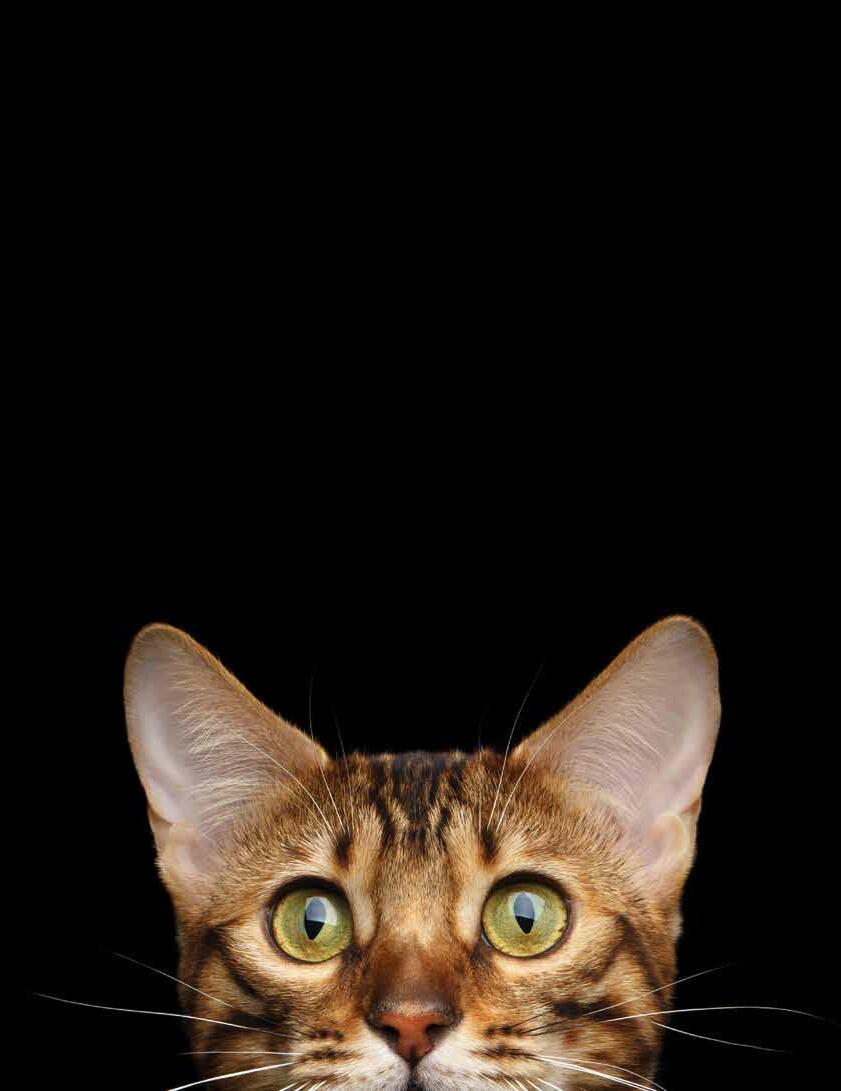
“The goals that we set here in our community to provide for loving companionship for all folks, doesn’t simply impact the lives of those receiving the companion, it impacts the lives of the family members who know without any question that the power of unconditional love can be seen.”
— Tim Scott
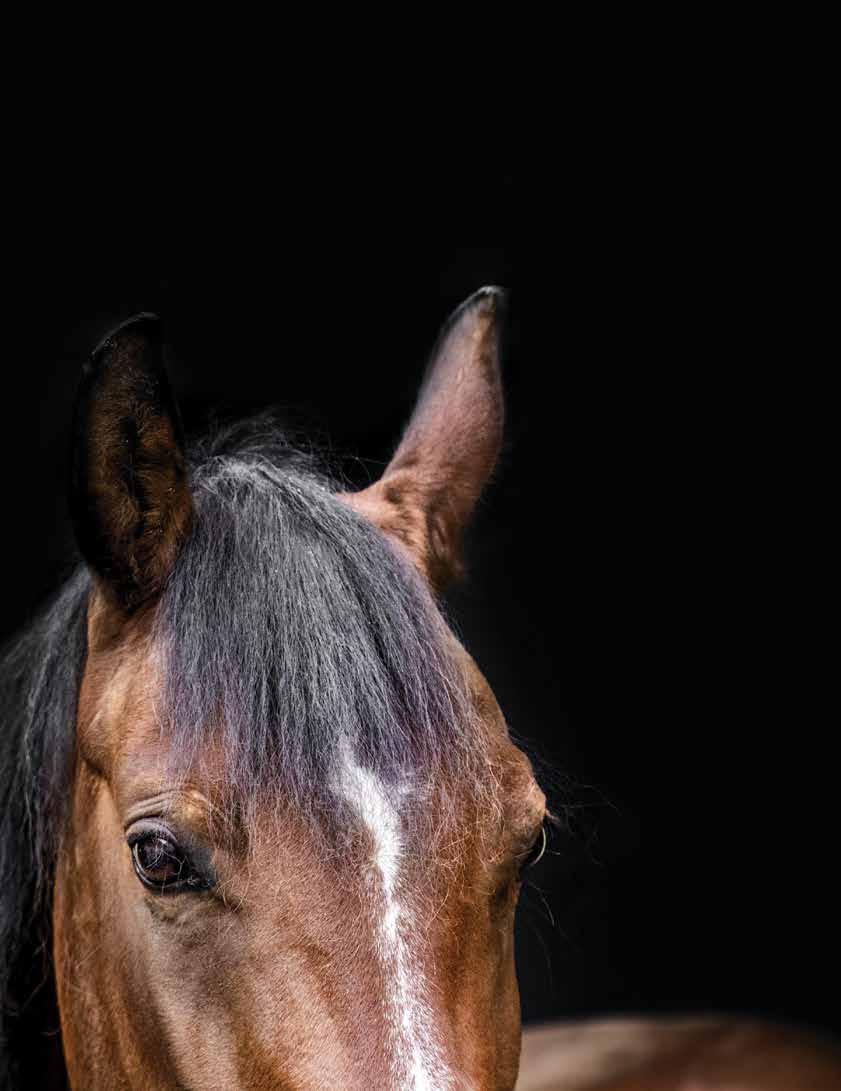
"We have a disproportionate responsibility to others. If there is an animal in need and we have the capacity to help that animal, we will."
— Joe Elmore
Charleston Animal Society President and CEO
2012-Present
THE COVER: At first glance, it may look like a simple photo of a horse, a cat and a dog, but look closer and you will see thousands of animals helped by Charleston Animal Society throughout the years. This collage is symbolic of the love, care and compassion for animals that Charleston Animal Society continues to stand for 150 years after its founding.
Editor-in-Chief
Dan Krosse
Managing Editor Joe Elmore
Graphic Design mclaughlin design
Copy Editors
Dan Krosse, Kylie Wiest, Sarah Baskin, Joe Elmore, Kay Hyman, Cristina Guillermo, Anna Lanford, Natassia Donohue, Will Howell, Lisa Pearce
Historical Consultant
Virginia Ellison
Writers
Dan Krosse, Joe Elmore, Sarah Baskin, Hank Greer, Laurel Greer, Kay Hyman, Anna Lanford, Heather Grogan, Aldwin Roman, Dr. Lucy Fuller, De Daltorio, Joy Huber, Abigail Appleton, Rainey Evans, Virginia Ellison, Elizabeth Bradham, Emma Gleave, Bernard Unti, Leigh Handal
Photographers
Jeanne Taylor, Will Howell, Kay Hyman, Dan Krosse, Alexandra Rostad, Marie Rodriguez, Mike Cejovic, Aldwin Roman, Patrick Allen, Marion Hanagriff, Greg Murray
Illustration
Christophe Drumain
Special Thanks
South Carolina Historical Society, Waring Historical Library at MUSC
Jane Graham (Co-Chair), Patricia Henley (Co-Chair), Laurel Greer, Louise Palmer, Virginia Ellison, Jennifer Garr, Joe Elmore, Kay Hyman, Dan Krosse, Anna Lanford
What a sesquicentennial year it has been! Throughout 2024, we were sure to incorporate the 150th anniversary of Charleston Animal Society into each of our major events. From our annual meeting in the spring, to the Gala and Paws in the Park in the fall, we shared the nostalgia and history of our organization that began back in 1874.
Inside the pages of our 150th Commemorative Edition, you will find the stories of the people and the animals who built the legacy of care we are so proud of. While our name has changed from “The South Carolina Society for the Prevention of Cruelty to Animals” (1874-1940), to the “John Ancrum SPCA” (1940-2007), to “Charleston Animal Society” (2007-present) — our dedication to improving the lives of animals has never wavered.
In the pages preceding this letter, you saw our callouts to “Leadership,” “Tradition,” and “Excellence.” Since 2012, these words have anchored our logo as a symbolic foundation for us to follow as an organization. In the first Constitution for the South Carolina Society for the Prevention of Cruelty to Animals these same themes were evident. In just five pages, the document spells out how the organization is to be run, with Article II articulating our core mission that is still alive and well today: “Its [the organization’s] object shall be to provide specific means for the prevention of cruelty to animals throughout this State and elsewhere.”
This magazine is a historical record of a lifesaving organization that has survived hurricanes, earthquakes, pandemics, economic upheaval, and wars. An organization is only as strong as its members. Time and again, you have risen to the occasion when our community animals needed your love, compassion, and financial support. As we always say, YOU are Charleston Animal Society. This commemorative issue is a testament to your dedication to our cause. Thank you for walking shoulder to shoulder with us for the past 150 years. Cheers to the next 150.
Martin Deputy Board President
More than 2,500 people celebrated Charleston Animal Society's 150th Anniversary at Paws in the Park on November 23, 2024 at Brittlebank Park in Charleston. It was South Carolina's largest event benefitting animals.
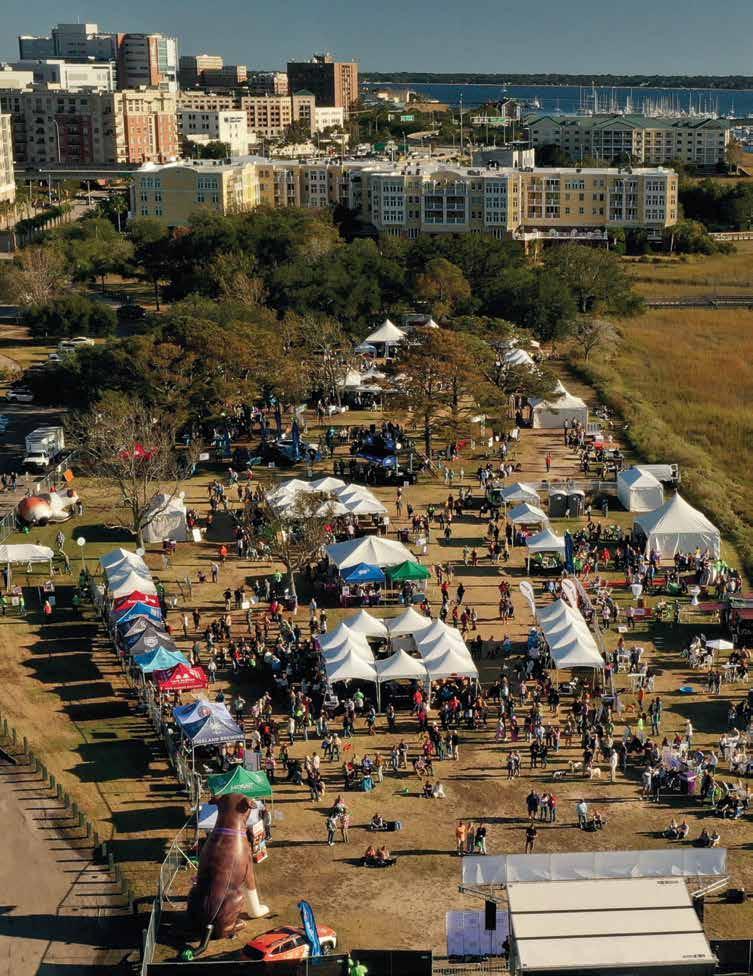
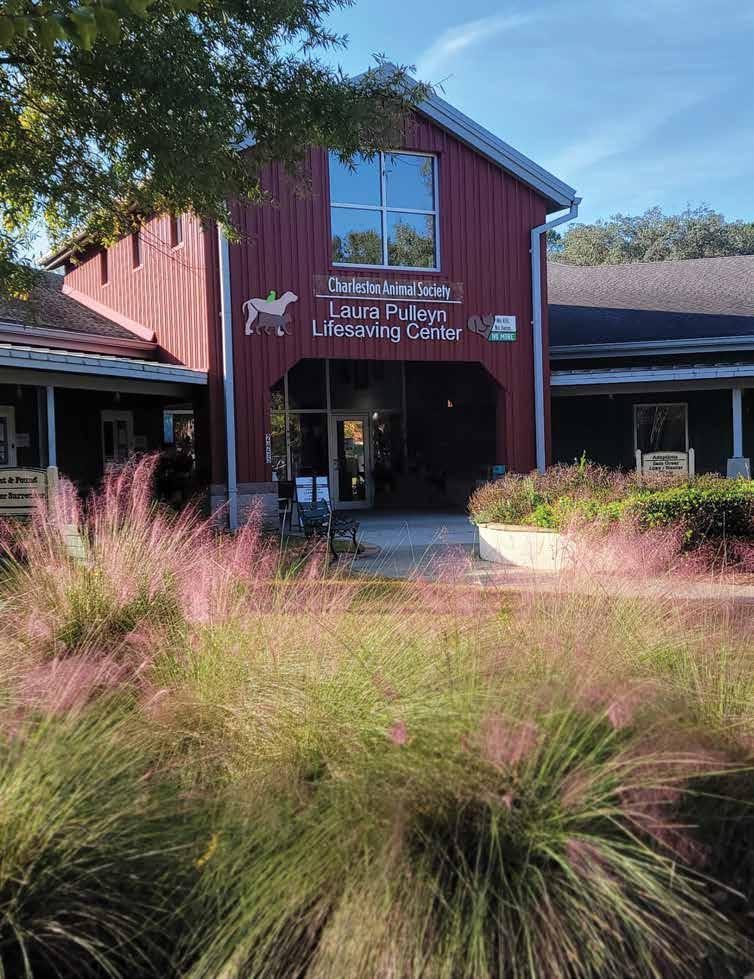
BY
BY SARAH BASKIN
Charleston Animal Society Gift Processing and Records Coordinator
In the latter half of the 19th century, Charleston–and the United States as a whole — was relatively unfamiliar with the concept of animal welfare and failed to employ humane tactics when dealing with the multitude of animals that resided in the city. However, Charlestonians would not sit idly by as cases of animal cruelty persisted. On March 14, 1874, South Carolina’s first animal organization — and one of the oldest in the nation — was born. Originally named the South Carolina Society for the Prevention of Cruelty to Animals, the organization had no physical shelter for housing homeless pets and instead focused on protecting working animals such as livestock, farm animals, and horses. Former College of Charleston President Nathaniel Russell Middleton was elected as the organization’s inaugural President upon its incorporation into a formal humane society in 1880.
Today, we know it as Charleston Animal Society, but this is not the only iteration of the organization. Nathaniel Middleton was succeeded by Dr. John L. Ancrum, a College of Charleston Medical Schooleducated physician. At his passing in 1900, Ancrum willed part of his fortune to the organization on the condition that it be named in his memory.
The estate took decades to settle, but when it did in 1940, the organization became the John Ancrum Society for the Prevention of Cruelty to Animals. The name lasted until December 2007 when the organization became Charleston Animal Society — just a few months before it relocated to its 31,000 square foot animal care campus at 2455 Remount Road in North Charleston.
The organization’s first shelter was built at 667 Meeting Street in downtown Charleston. Following that, in 1948, there were two sites in West Ashley from 1951 through 1980, and one more on Leeds Avenue in North Charleston, before the move to Remount Road.
Using lifesaving strategies based on scientific research, Charleston Animal Society created the first No Kill Community in the Southeast in 2013. Despite the challenge of taking in more than 90% of Charleston County’s animals, the Animal Society was saving every healthy and treatable animal for the first time in its history.
The monumental No Kill Charleston achievement came after decades of work by Charleston Animal Society to lower euthanasia rates and push for more humane methods in the treatment of animals. The building blocks to success included growing public spay-neuter efforts, starting compassion education for children, and working in partnership with national organizations like the ASPCA.
Charleston Animal Society remains dedicated to improving the plight of animals now and in the future. Had you visited the lifesaving center in 2024, you would have seen a starving horse receiving care, a cat named Daniel leaving for a loving new home after months of treatment for a variety of skin and eye conditions, and a dog named Champ, one of 52 dogs and kittens brought to the Animal Society for lifesaving care on the same day.
As we celebrate 150 years, Charleston Animal Society has closed in on a new historical goal: No Kill South Carolina. With you by our side, we know the organization can lead communities across the state to the same success we have sought since 1874.
BY DAN KROSSE Editor-in-Chief
Charleston Animal Society came to life as a cadre of animal protection “societies” were formed in the country’s principal cities during the late 1800s.
The organization’s primary focus was on working animals like horses and livestock. Society members were given a metal badge that identified them as animal crusaders. Turn-of-the-century minutes from Society meetings detail the organization’s efforts to protect horses and mules. “The worst stock in our city are poor mules and horses driven by the wood yard people. If our citizens and ladies would only refuse to purchase from that class of dealers who own these poor, unfit for use beasts … they would go out of business,” wrote President J. Alwyn Ball in 1910.
In the mid-1890s the Society took on a major corporate force of the era — the railroads. The SCSPCA wanted assurances that livestock were being transported on rail cars in the most humane way possible. Letters from the managers of the Savannah Railway and the South Carolina Railway can be found in the historic archives of the Society. “I beg to say that I heartily agree with you in your stand. I will have our agents report such [cruelty] cases promptly as you suggest,” wrote SC Railway General Manager C.M. Ward.
When a judge mishandled a cruelty case in 1894, Society President John Ancrum went public. He criticized Justice Williman for failing to call a key witness — the driver of the horse! Ancrum threatened to go to the legislature if cases were not given their due course. The judiciary took notice.
In the 1910 annual report, published in the News and Courier, President Ball reported that 15 cases involving horses and mules were prosecuted, with 14 people being found guilty. 127 horses and mules were cautioned and removed from the streets and sadly, 17 horses and mules were euthanized after suffering broken limbs.
A man who operated a moving company that took people’s furniture from Charleston to Sullivan’s Island for the summers was reprimanded by the Society. His horse would constantly fall from being overloaded. Ball wrote, “I should like to see someone who is manly enough to have this man arrested and prosecuted … for cruelty.”
By 1913, Ball noted improvements thanks to the Society’s vigilance. “Night Hawk” transport agents (somewhat like turn-of-the-century Uber drivers) were “buying a better class of animal.” Horses used in the post office mail wagons were treated better. Ball reported that people were feeling “the weight of the Society” and were taking better care of their animals.
The SCSPCA was constantly looking for ways to improve the lives of horses and livestock — even pursuing placing water fountains around the city for horses.
As the automobile age zoomed on to the American scene, the Society’s focus shifted from horses to dogs and cats, but these magnificent creatures have always stayed on the Society’s radar.
The SCSPCA would walk the streets of Charleston looking for horses and mules in distress.
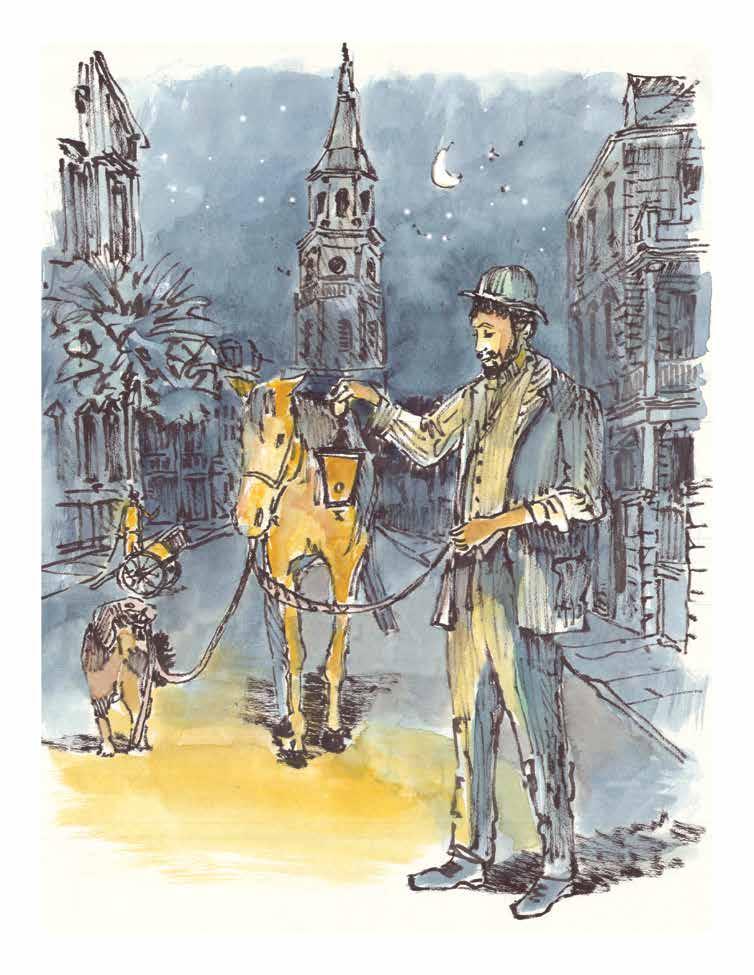
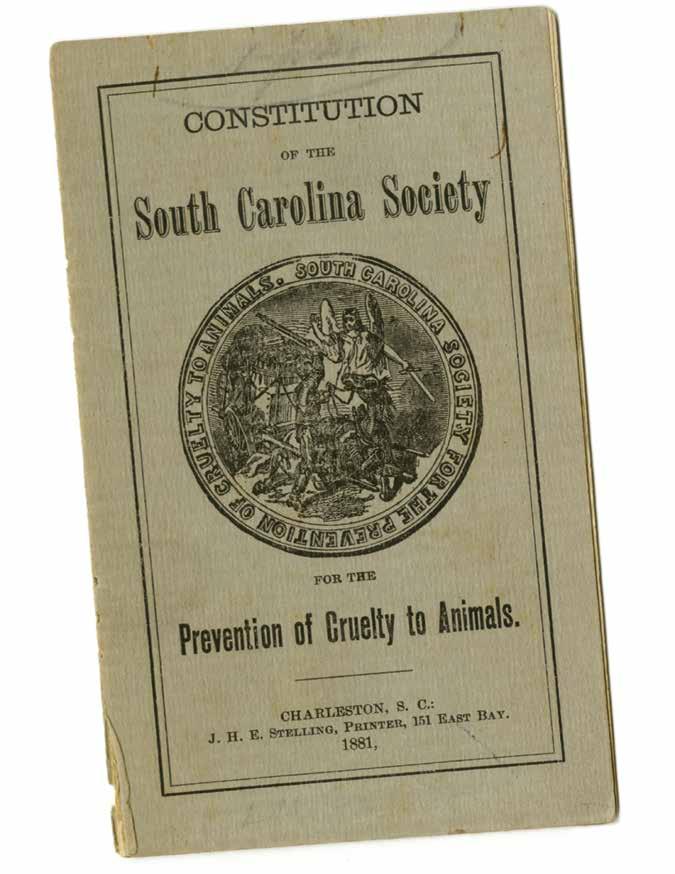
1880: Nathaniel Russell Middleton
1884: Dr. John Ancrum
1900: J. Alwyn Ball
1914: W.K. McDowell
1932: Mrs. Julia Gordon
1947: Louis M. Gourd
1952: Rev. Alfred Hobart
1954: George C. Birlant
1955: Benjamin J. Badger
1959: Mrs. M.L. Gourd
1960: Margaret Waring
1961: S.T. Califf
1969: Park B. Smith
1972: Carroll Godwin
1975: Albert Tiedeman
1976: Dr. James Southard
1978: John Kerr
1980: Dr. James Southard
1983: Ronald Rowland
1986: Dr. James Southard
1989: Dr. Dennis Feinberg
1990: Ronald Rowland
1992: Annette Roberts
1997: Margo Kaynard
1999: Dawn Porter
2000: Charles Karesh
2009: Cynthia Legette
2010: Hilton Smith, III
2011: Charles Karesh
2011: Barbara Eggers
2013: Elizabeth Bradham
2017: Hank Greer
2020: Laurel Greer
2024: W. Martin Deputy
BY DAN KROSSE Editor-in-Chief
As he stood aboard the confederate battleship the CSS Nashville during the Civil War, one wonders if the ship’s doctor, John Ancrum, ever thought he would be instrumental in creating a legacy for animals that lasts to this very day.
Dr. John Ancrum graduated from the medical school at the College of Charleston, and would be one of the first organizers of the South Carolina Society for the Prevention of Cruelty to Animals (SCSPCA), that eventually became Charleston Animal Society.
While the official charter for the SCSPCA was granted by the legislature in 1874, it would take six years for the group to organize with an official constitution in 1880. Ancrum was joined by other well known Charlestonians like Nathaniel Russell Middleton, and J. Alwyn Ball.
When Middleton retired as the first president of the organization in the early 1880s, Ancrum stepped in with enthusiasm to steer the course until 1899. During his tenure, he encouraged the organization to hire the first “cruelty detective.” He worked with police to make sure animal neglect cases were being investigated and he even chastised a judge publicly in 1894 for not taking a case seriously — threatening to go to state lawmakers. This trailblazer also asked the legislature to allow the SCSPCA to work with abused children, as there were no child advocacy organizations at the time.
Ancrum continued to give to the animals even after his passing on August 17, 1900. In a complicated will, Ancrum bequeathed the remainder of his fortune to the SCSPCA – but only after his wife Jane and two
other relatives (who received annuities) died. He also gave $495,000 (in 2024 dollars) to the Porter Military Academy, which was located on what is now the MUSC campus in Charleston.
Another key caveat to the will – the SCSPCA would need to change its name to the “John Ancrum SPCA” upon receipt of the inheritance.
Legal wranglings over Ancrum’s will and its exact meaning would last four decades. Attorneys for the SCSPCA inquired if they might qualify for the fortune early. The attorney representing the Ancrum estate was a brand new lawyer who would eventually become a U.S. District Judge in Charleston, J. Waties Waring, a civil rights legend.
In response to the SCSPCA’s request, Waring wrote, “As under the terms of the will there are two annuities which must be paid, and this bequest is ‘subject to the annuities’ I do not suppose there is a probability of an early settlement.”
In 1940, the estate was finally settled and the John Ancrum SPCA was born. The inheritance (about $500,000 in 2024 dollars) revitalized the organization and in 1948, the first shelter in its history was built in downtown Charleston at 667 Meeting Street.
For 67 years, the organization bore John Ancrum’s name until it became “Charleston Animal Society” in 2007. To this day, many Charlestonians still refer to the organization as “John Ancrum,” a testament to the legacy of just one man.
Dr. John L. Ancrum gave his fortune to the animals.
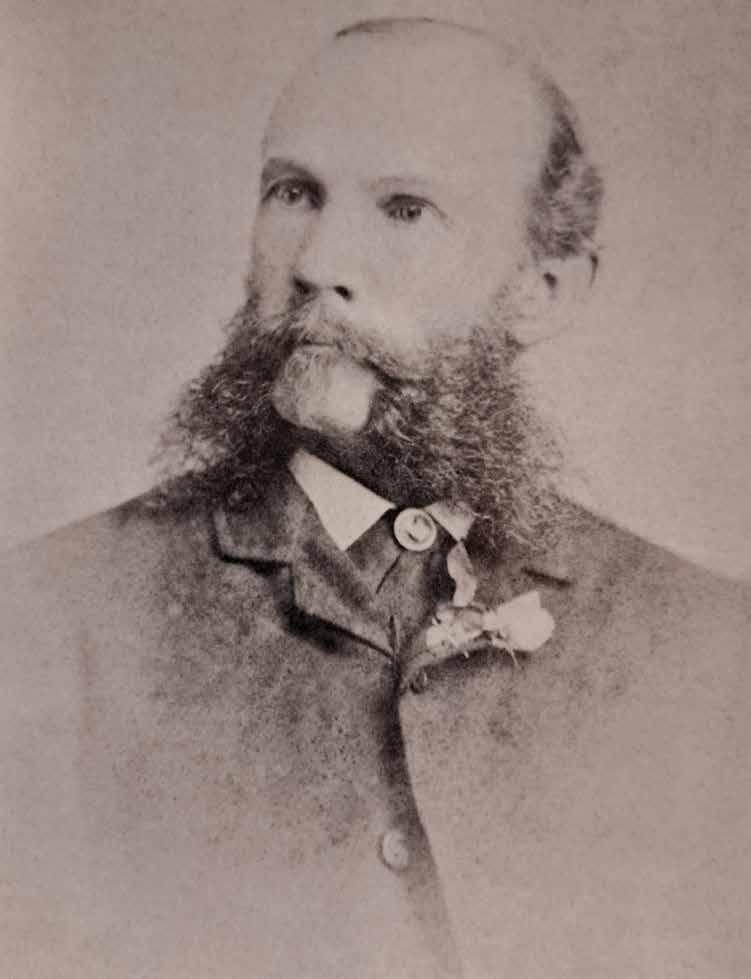
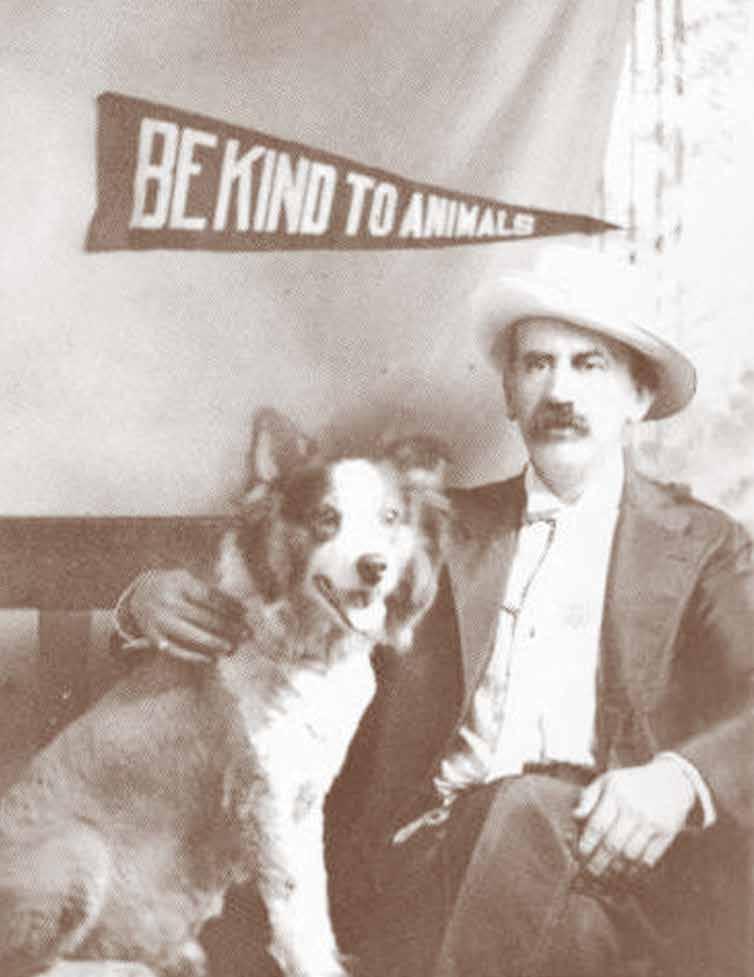
BY BERNARD UNTI
Humane Society of the United States Senior Principal Strategist in Communications
It is a portrait of intimacy and friendship, the photograph of a man sitting with his collie on a bench, his right arm draped around the dog’s neck. A pennant with the words “Be Kind to Animals” hangs above them, as they gaze serenely and contentedly toward the camera.
But this is not just any picture. It is a stepping stone to the modern movement that celebrates the humananimal bond and calls us all to a higher standard of treatment for animals.
The man is Henry Lewith, of Charleston, and the dog — Beauty — his cherished pet. In 1914, the American humane movement took up the slogan Lewith coined, “Be Kind to Animals,” as a rallying cry.
Observed in May by humane societies around the country, Be Kind to Animals Week has been celebrated in parades and proclamations, broadcast through the media, and plastered on posters, literature, pins, pennants, and signs.
Lewith, a linotype operator and proofreader, was a lifelong animal advocate who from his earliest years rescued animals from the pound and the streets. Retiring early, he used a family inheritance to devote all his time to humane work. He and Beauty were a familiar sight in their walks around Charleston.
Since 1864, in England, the Royal Society for the Prevention of Cruelty to Animals had been sending appeals to the clergy to preach on kindness to animals on Trinity Sunday (the first Sunday after Pentecost).
Nothing similar had taken hold in the United States,
although Mary F. Lovell, a Philadelphia humanitarian with ties to the Women’s Christian Temperance Union, had been calling for an American Mercy Sunday.
Lewith, a devout Jew, believed a secular approach would be more successful. Lewith lobbied other advocates to support a week focusing on the slogan as a way of getting the cause before the public. At the 1914 meeting of the American Humane Association, delegates adopted a resolution of support. The concept quickly took hold, with one day, Humane Sunday, set aside for sermons on the treatment of animals.
Lewith reportedly spent as much as $40,000 ($1.2m in 2024) from his inheritance on printing banners, pins, badges, and other promotional materials. But he gave Be Kind to Animals Week its strongest boost with a 24-page supplement about humane issues that appeared on Easter Sunday 1919 in the Charleston American. This was the first time any newspaper had afforded such space to the anti-cruelty movement, and Lewith printed thousands of copies for national circulation. One caught the attention of an Ohio newspaper owner, Warren G. Harding, who adopted the insert for his paper. Several years later, in 1921, as President of the United States, Harding attended a Be Kind to Animals Week parade led by his dog Laddie Boy.
In 1926, at 50 years of age, Lewith took ill and was hospitalized. Newspapers reported that Beauty died of grief at not being able to see him. Two weeks later, Lewith passed away. But, like the photo that documents their mutual devotion, Lewith’s call to compassion, as poignant as ever, lives on.
BY DAN KROSSE Editor-in-Chief
Acommon misconception is that Charleston Animal Society was formed to house homeless animals. It wasn’t until 74 years after its founding that the Animal Society began to shelter animals.
In 1948, building began on the first shelter located at 667 Meeting Street. From downtown, the Society moved to West Ashley, setting up first on St. Andrews Boulevard and then on Dupont Road in the 1960s. After this era, the Animal Society operated out of a trailer next door to the jail on Leeds Avenue for 24 years. But the Society had to move from this Leeds Avenue location when the Sheriff’s Office needed the land to expand the jail. In 2008 the current animal care campus at 2455 Remount Road opened — but it may have never happened if it weren’t for a South Carolina political icon.
Senator Ernest “Fritz” Hollings was born in Charleston, graduated from the Citadel, served in World War II, and rose through the ranks of state politics to become Governor in 1958. Not through with politics, Hollings became a U.S. Senator in 1966 and would remain in office for 38 years, serving on several powerful committees. He even ran for President in 1984.
Hollings was a political legend.
So, when Charleston Animal Society was running into problems getting their new location on Remount Road finalized, they turned to Hollings for help.
After other property deals fell through, North Charleston Mayor Keith Summey, who was a key supporter, said Charleston Animal Society could get several acres of Air Force base property off Remount Road that was scheduled to be given to the City of North Charleston.
Those familiar with the negotiations said this all sounded great until the Air Force let Charleston Animal Society know that they had decided to sell the property on the open market.
Stunned by the news, the Society’s building committee reached out to Senator Hollings in 2005 for help. While he had just retired from the Senate, he still had strong connections in Washington.
One person at the meeting with Hollings remembers the retired Senator asking his assistant to call the new senior Senator from South Carolina, Lindsey Graham. According to those present, Graham told Hollings he was aware of the problem, but he had made no headway toward a resolution. In an epic throwdown, Senator Hollings told Senator Graham, “Lindsay I don't want to tell you how to do your job, but if I were you, I would call [the General] into your office and tell him if the property does not pass to the Animal Shelter and North Charleston in 60 days that we would see that $6 billion was cut from the Air Force appropriations.”
Witnesses say Charleston County Councilmembers present at the call almost “fell out of their seats.”
Hollings reminded Senator Graham that Hollings had legislation passed before he left office that if any government land was not used it would come back to local governments.
By chance, Air Force leaders were coming to North Charleston the following week to meet with Charleston Animal Society, and Senator Hollings attended the meeting ready for a fight. But as Senator Hollings entered the room, the Air Force representatives immediately made it known that they had received his message loud and clear — and Charleston Animal Society received the land for a new animal care center. The next year, Hollings was front and center at the groundbreaking.
Senator Fritz Hollings was instrumental in helping Charleston Animal Society obtain land from the Air Force for their current campus.
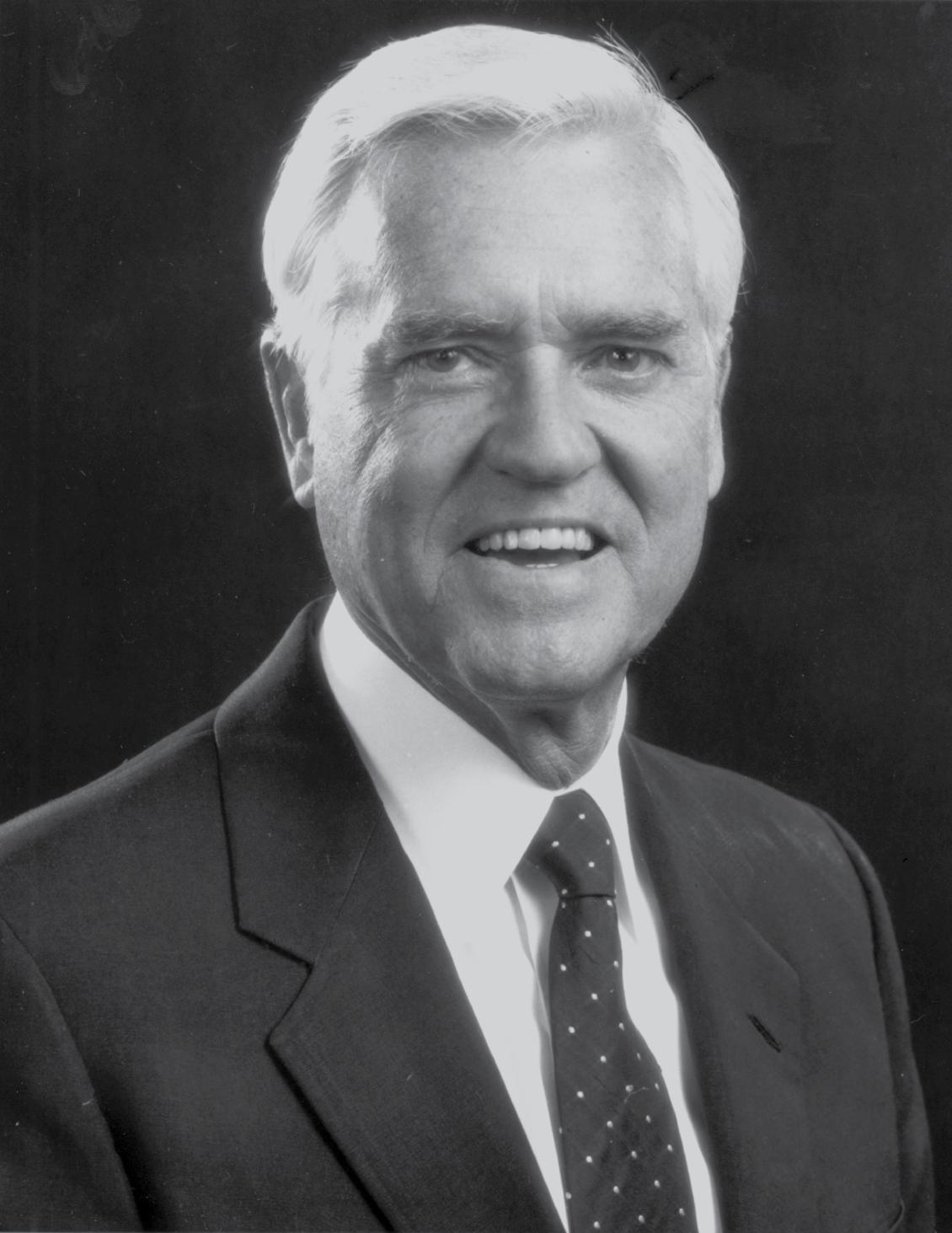
Charleston Animal Society Emergency Response Manager Bryant Taylor helps rescue dogs in a 2022 cruelty case.
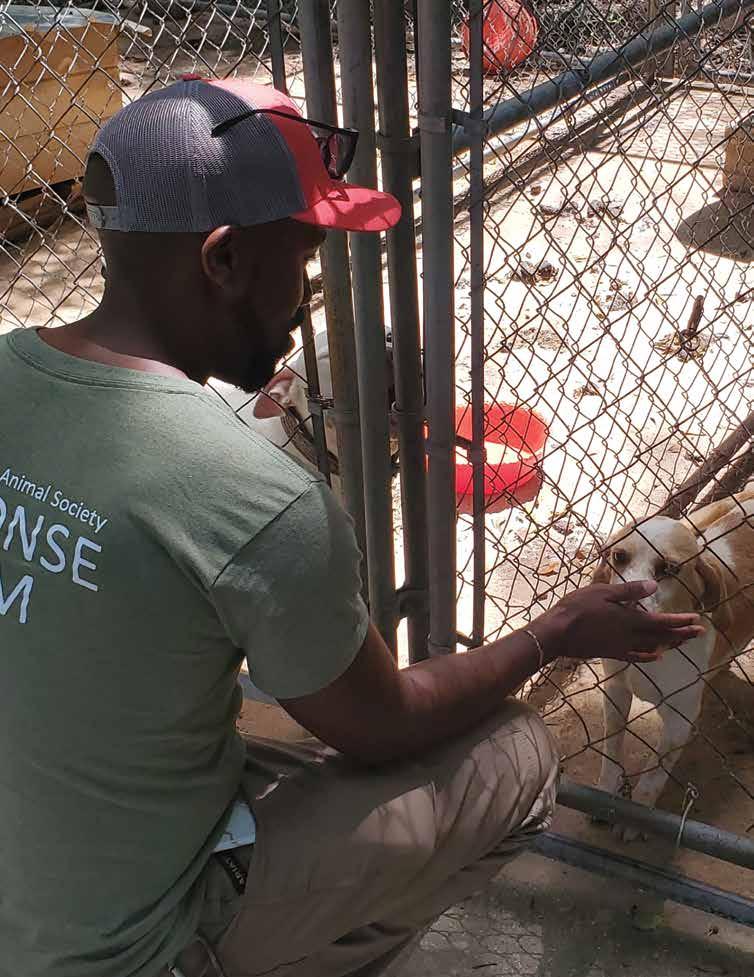
BY ALDWIN ROMAN
DAN KROSSE Editor-in-Chief
The mission of Charleston Animal Society has always been the same. It was actually written into the first name the organization ever had — the “South Carolina Society for the Prevention of Cruelty to Animals.” The dedication to the anti-cruelty mission was codified into the organization’s constitution in 1883.
Nathaniel Middleton, the first president of the Society, wasted little time letting the Society’s intent be known. Soon after he was elected in 1880, Middleton expressed his frustration in a newspaper article because the state legislature did not pass an anti-cruelty law.
Early on, anti-cruelty efforts focused on working animals like horses. But documents from the turn of the century show the Society calling out dog catchers for grabbing dogs by hind legs and “jamming stakes down their throats” during captures. The Society proposed nets and other more humane methods being used by other cities.
In 1894, the Society hired its first “Special Detective.”
During an initial two-month trial basis, the detective found 11 cruelty and neglect cases in the streets of Charleston, including many half-starved mules and horses. Some drivers and owners were arrested and charged with cruelty.
In a highly publicized case in 1947, Charleston Animal Society won a cruelty conviction involving gander pulling. Popular around Easter Time, this horrendous sport involved contestants on horses riding by a goose strung on posts upside down. The goal was to tear the goose’s head from its body on the ride by.
While there were several other cases along the way, the modern era of the Society’s cruelty fight was ignited
in 2004 when a booby trap went off on a Charleston County property, shooting a surveyor in the leg.
Investigators found 47 pit bulls and dog fighting equipment on David Tant’s property. All of the dogs were brought to Charleston Animal Society during the prosecution, which lasted several months (see page 31).
Starting in 2006, Charleston Animal Society begain advocating for better working conditions in the carriage tourism industry in Charleston. Although Charleston Animal Society is not against working animals, such as carriage horses and mules, the organization wanted assurances the animals were working in humane conditions.
In 2021, Charleston Animal Society deployed teams to assist in the largest cruelty bust in state history in Laurens County. Over 400 animals needed help in the rescue operation, including dogs, horses and various farm animals. All were seized by law enforcement. Twenty-three dogs were transported to Charleston Animal Society for emergency medical care by the shelter’s veterinarians and animal care staff. The Society receives regular requests from local, state, and federal law enforment agencies to assist in animal cruelty operations across South Carolina.
Caitlyn’s Anti-Cruelty fund was set up at the Society after an awful case of cruelty that involved a dog’s muzzle being taped shut (see page 48) Charleston Animal Society works closely with national organizations like the ASPCA and the Humane Society of the United States as a quick responder in South Carolina and the Southeast.
“We are committed to fighting cruelty, wherever it exists,” said Charleston Animal Society President and CEO Joe Elmore.
BY LEIGH HANDAL
Historian and Author
In 1999, Hurricane Floyd was heading straight for the Lowcountry coastline as a powerful Category 4 storm. I don’t know what I would have done without the John Ancrum SPCA. The organization was a lifesaver for someone trying to evacuate alone with 19 rabbits, a dog, and a guinea pig!
The shelter had convinced county officials to open the North Charleston Coliseum to animal owners and their pets, and as I looked around that day, I saw at least a thousand people and about as many animals across the stadium floor. Thankfully, Floyd veered north at the last possible moment.
A decade earlier, Charleston did suffer a direct hit from Hurricane Hugo. As reported in the Evening Post in 1989, when Hugo tore across the Lowcountry, Willie Gibbs and his Uncle Harrison were the two volunteers who bravely spent the night at the John Ancrum SPCA on Leeds Avenue, safeguarding 150 animals in the shelter’s care. Nearly 41,000 pounds of food came pouring into the shelter from around the country after news of Hugo’s 20-foot storm surge and 160-mile-perhour wind damage were broadcast around the world.
NOAA records list 30 major hurricanes that have passed over or near Charleston in the 354 years since it was founded. That’s about once a decade.
One of the first things even a casual student of Charleston history realizes is that disasters have played a huge role in our region’s historical narrative. Dogs, cats, horses, mules, and other livestock faced the challenging winds and rising waters. Historic accounts indicate that some made it through. Others didn’t.
In 2020, a worldwide pandemic struck and Charleston Animal Society showed its dedication to the community by never closing its doors to the public, even with the
challenges and fears that COVID brought. Despite worries that pets may be contagious with COVID (there were very few instances around the world), people continued to adopt as they found solace in their pets when it seemed the entire world was shutting down.
More than a century earlier Charleston had survived the 1918 Spanish Flu pandemic, which came in through the Navy Base.
Fire was also a part of Charleston’s challenging past. Large parts of the city were destroyed by several fires starting in 1698. The largest, the Great Fire of December 11, 1861, scorched a 540-acre swath across the peninsula — destroying a third of Charleston’s residences, businesses, and civic buildings. One can only imagine the terror animals faced during those blazes.
Perhaps the most devastating natural disaster in Charleston’s history occurred on August 31, 1886, when the largest earthquake ever recorded on the U.S. East Coast struck Charleston. Estimated to have registered between 7.2 to 7.4 on today’s Richter scale, the quake could be felt as far away as Chicago, New York, Cuba, and Bermuda. Buildings crumbled, trains fell off their twisted tracks, and 60 deaths were recorded.
Yet through all of these catastrophes — hurricanes, pandemics, fires, and earthquakes, Charleston Animal Society has remained a steadfast presence to help pick up the pieces and focus on those without a voice — the animals who survived.
Key safety strategies like wearing masks allowed volunteers and staff to continue their disaster response work for the animals throughout the 2020 pandemic.
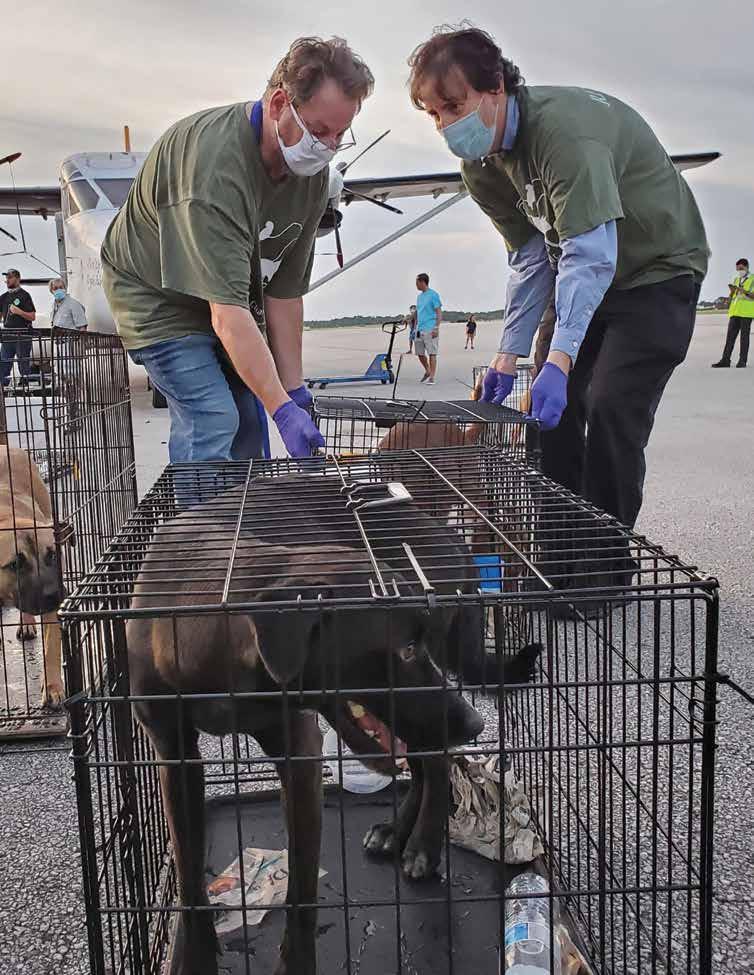
A cat up for adoption at Charleston Animal Society in 2023.
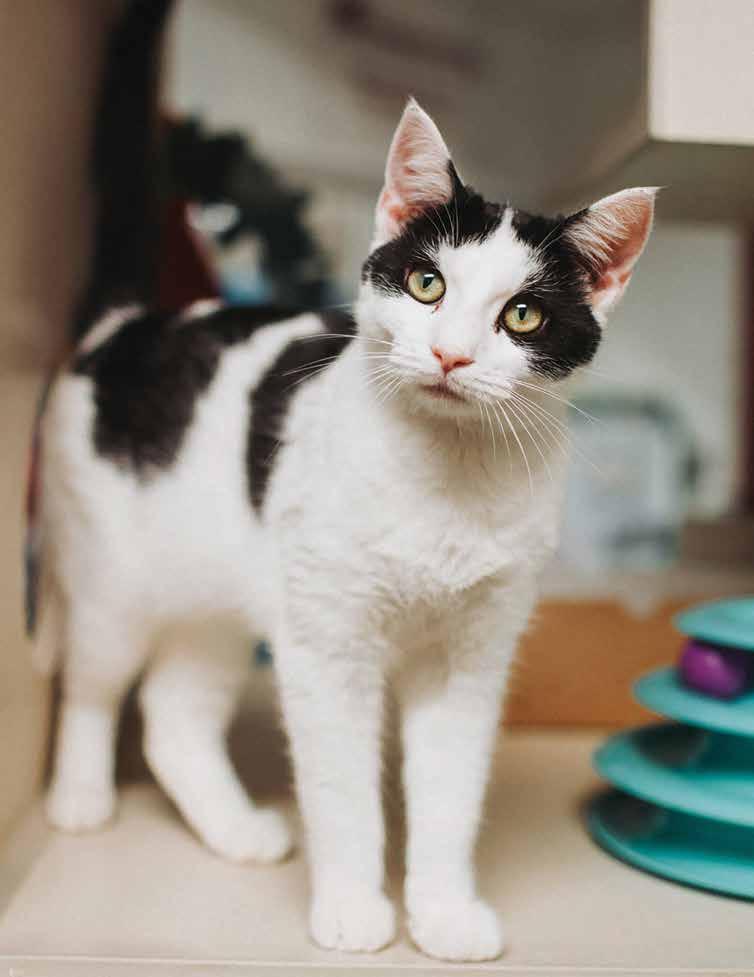
BY ALLIE ROSTADT
BY DAN KROSSE Editor-in-Chief
When studying the history of Charleston Animal Society, one learns dogs would become a focus in the late 1800s, but cats are really nowhere in the picture until the late 1940s.
Of course cats were living in Charleston — historians believe felines came to America with the early settlers from Europe. The cats were likely brought over on ships for rodent control. These cats continued this important job as Charleston grew into a bustling East Coast seaport.
In her book Pets in America, historian Katherine C. Grier writes that “Proven mousers were so prized that city folk could rent them from exterminators and animal dealers.”
Like the rest of us, cats have to “go” when they need to “go.” In the 19th century, some enterprising owners, concerned about their cats’ bowel movements, might fill boxes with sand, ashes, dirt and newspaper – but most cats lived the majority of their lives outdoors. Things would change dramatically for cats in 1947. That’s when Ed Lowe, fresh off a navy ship from World War II, invented a substance he named “Kitty Litter.” His neighbor asked for his help after she had run out of sand for her cats, so he took her some clay pellets, which she told him worked much better. The invention made Lowe a millionaire and opened the door for cats to start living in homes on a much wider scale.
Refrigeration (for canned food), flea control, and spay-neuter also made way for cats, but the kitty litter invention was arguably the biggest boon to domesticating cats.
Charleston Animal Society (then the John Ancrum SPCA) built its first shelter in 1948 at 667 Meeting Street. In a history regarding its condition, the author writes “In a few years the number of stray dogs and cats awaiting adoption overcrowded this facility.” This is the first documented mention of cats researchers could find in the organization’s archives.
In 1961, the organization moved to 820 Dupont Road in West Ashley, where organization historian and former President S.T. Califf described “stainless steel and fiberglass cages for dogs and cats.”
INNOVATION = BRIGHT FUTURE
Charleston Animal Society is constantly looking for innovative ways to get animals adopted. Their TVAR program (Trap-Vaccinate-Alter-Return) was groundbreaking for the area. The Pounce Cat Cafe opened on Meeting Street in the heart of the tourist district, offering visitors the chance to mingle with cats as they eat and drink. All of the cats come from Charleston Animal Society and thousands have been adopted to homes across the country since the cafe opened in 2016.
Charleston Animal Society’s Bear Greer Memorial Cat Sanctuary is an oasis for feral cats. 126 felines roam five acres of land in Ravenel that include several different enclosures with warm beds, full time staff, and an onsite clinic.
The future for cats under Charleston Animal Society’s care looks bright. In 2003, John Ancrum SPCA records showed 73% of cats brought to the shelter were euthanized. Twenty years later, with a heavy focus on fostering, adoption, spay-neuter and the TVAR program, that number dropped tenfold to 7%. Cats that are currently euthanized suffer from untreatable conditions.
BY KAY HYMAN
Charleston Animal Society Senior Director of Community Engagement
After 31 years of witnessing the amazing transformation of thousands of neglected animals that have passed through our doors, it never ceases to amaze me how much adopting a homeless animal can change lives. From helping a child with autism to a Vietnam Veteran who suffers from post-traumatic stress or a family grieving the loss of a family member, the bond is magical.
For me, a monkey almost got in the way of my first adoption experience.
At 10 years old, all I wanted was a kitten. The year was 1969, my birthday, just three days before Christmas. After years of begging for a kitten, my father finally took me to visit the John Ancrum SPCA on Dupont Road in West Ashley. When we arrived, I was saddened to learn I couldn’t see the kittens because there was a monkey in the shelter and children were not allowed near it. Why there was a monkey in the shelter, I do not know, but this news nearly broke my dad (who was not a fan of kittens or monkeys), but he begrudgingly went to choose my new friend for me.
My dad returned with a beautiful brown and tan kitten. It was love at first sight and I named him Cocoa, and he became a member of my family. Cocoa was an outside cat and within months, we discovered he was a she after she became pregnant. Cocoa gave birth to 5 kittens, and I was in complete heaven. The magic I felt caring for those kittens and their mom filled my summer of 1970.
Of course, I had to figure out how to find them homes. I hatched a marketing plan, made little bags of food, tied bows around their necks, and took the kittens to the mall. I was very proud of myself because I found new loving homes for all the kittens. In no time, Cocoa
was pregnant again, and this time my dad said we had to take the kittens to the shelter. I gave them to the shelter and a couple of days later, I went back to visit them and found out that they had been euthanized.
I was devastated! So, I saved my money and we got Cocoa spayed so there would be no more unwanted kittens. That was a lesson I would never forget.
Twenty years and many adopted animals later, I began volunteering at John Ancrum SPCA on Leeds Avenue. I have adopted many birds, cats, and dogs from the shelter, including the loves of my life: two Shelties named Princess and Rascal.
Adopting Cocoa in 1969 was the catalyst for becoming who I am today. The lessons learned and the animals who came in and out of my life helped me find my voice for animals and inspired my career at Charleston Animal Society. 31 years later, I am still in love with that universal hope of finding the perfect home for the animals in our care and the healing it brings to our planet.
Adopting a shelter pet is magical and it will change both your life and theirs.
Kay Hyman, 10, with her adopted cat Cocoa. This adoption would inspire her lifelong passion for animals.
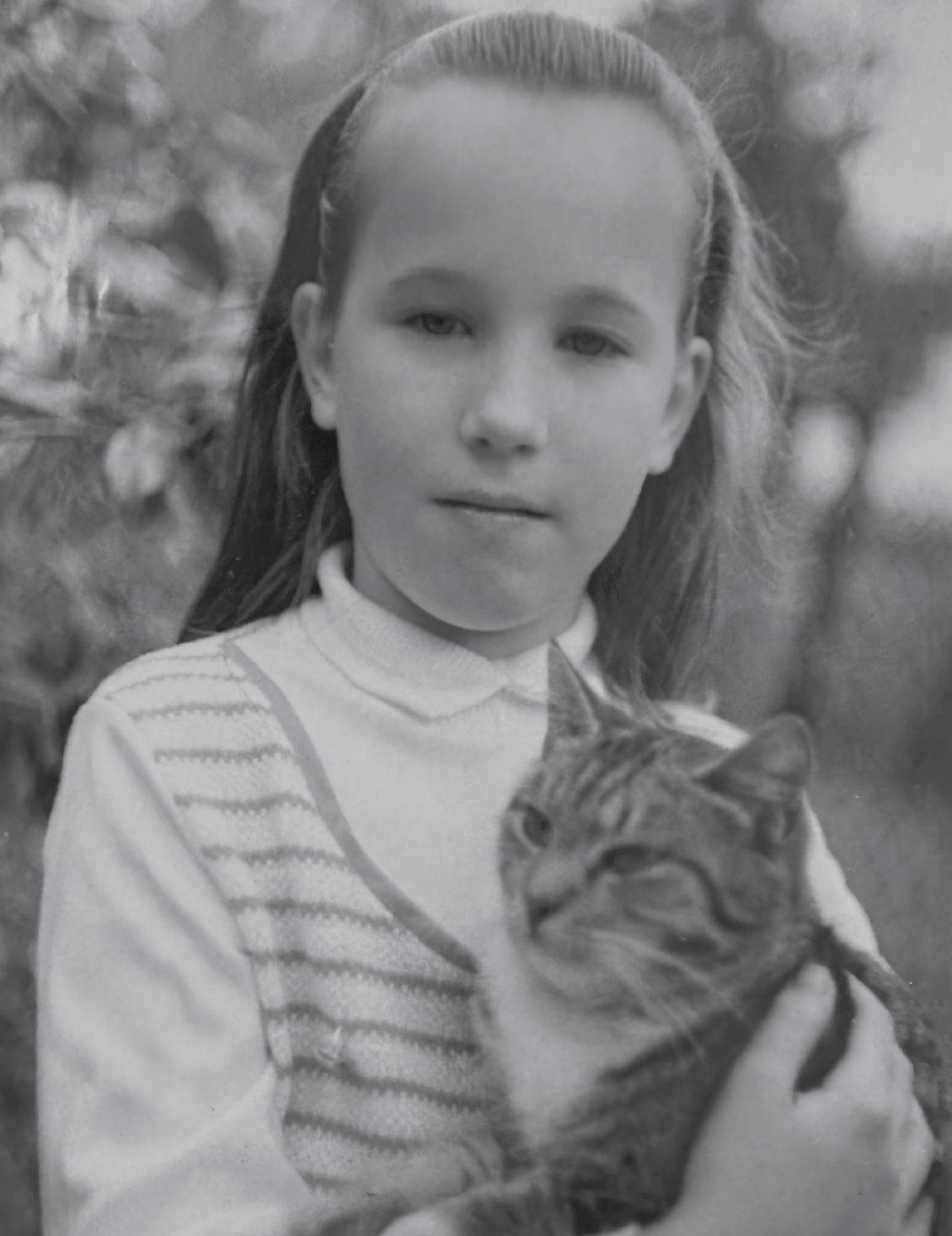
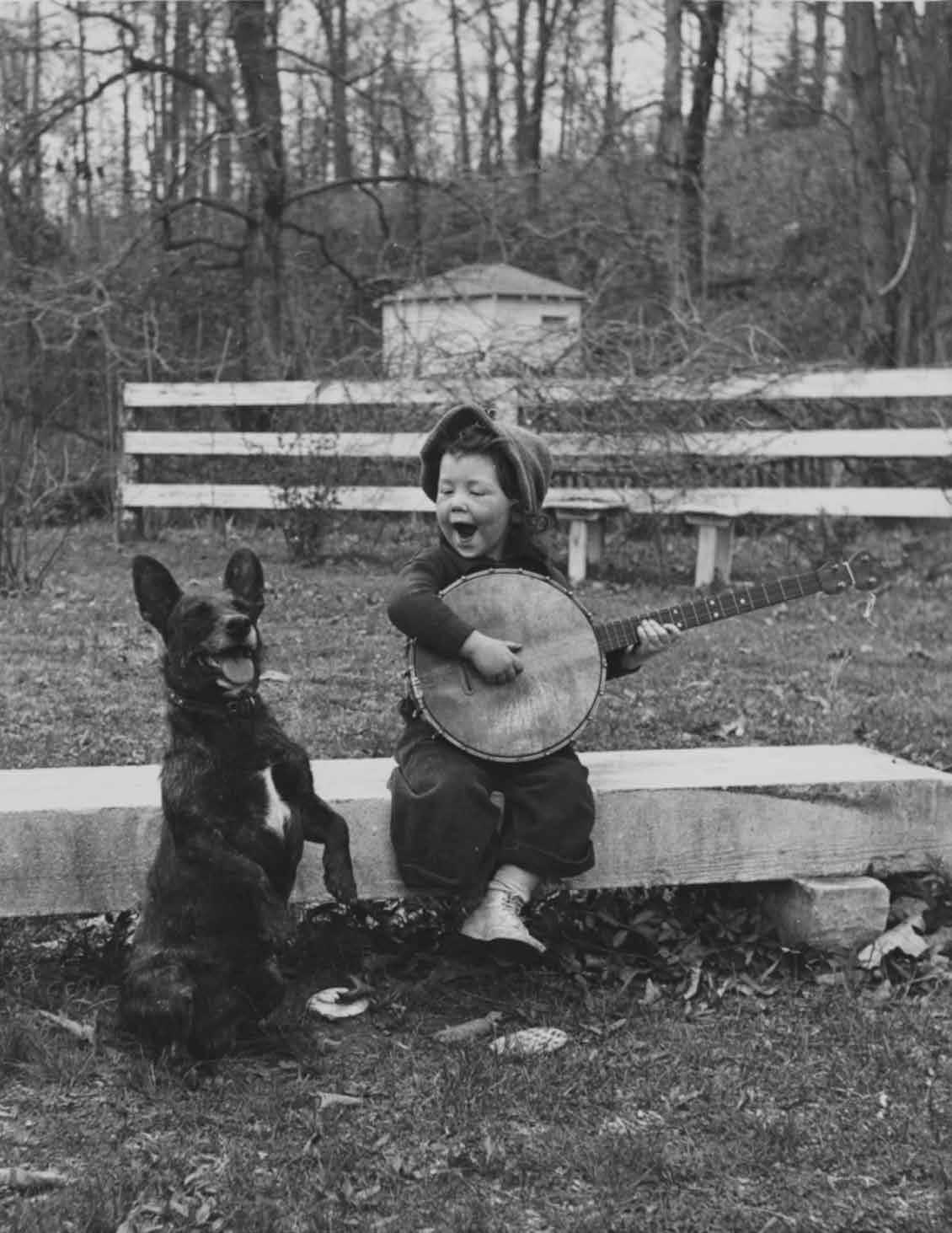
BY ANNA LANFORD Charleston Animal Society Advancement Assistant and Events Coordinator
It may be surprising to learn, but the founding fathers of Charleston Animal Society at one point lobbied lawmakers to allow them to also protect children. The year was 1891. The organization’s president at that time was Dr. John L. Ancrum, a physician who advocated for the new laws because he had received numerous reports of child abuse happening in Charleston. When families turned to the organization (then the South Carolina Society for the Prevention of Cruelty to Animals) there was nothing the organization could do — their hands were tied.
Ancrum drafted a resolution to change that: “The South Carolina Society for the Prevention of Cruelty to Animals memorializes the Legislature to embrace in their laws the power to prevent the cruelty to children, and that the solicitor for said Society, be requested to draft such laws to be enacted.” The members of the Society were enthusiastic about the proposal, and were thrilled at the idea of having the ability to help children in poor conditions.
As progressive as the proposal was, it was not the first in the country. Seventeen years earlier, a heartbreaking case of child neglect illuminated a nationwide need for protection agencies for children. In New York City, 10-year-old Mary Ellen Wilson faced physical abuse and neglect at the hands of her adoptive parents, and neighbors started to express their concern.
The police refused to intervene, and there were no child protective services or other programs for children that could protect her. Seeing no other options, the case was brought to the attention of Henry Bergh, founder of the ASPCA, who saw similarities between the treatment
of this child and the animals that he worked tirelessly to save from poor conditions.
Thankfully, Bergh was able to use his connections to get the legal help to remove Mary Ellen from her home and get her to safety. Inspired by this case, the New York Society for the Prevention of Cruelty to Children was founded later that year as the first child protective agency in the country.
Our research was unable to determine how far Ancrum’s resolution in Charleston moved forward. However, by the turn of the century there were more than 350 anti-cruelty organizations in the U.S. and 185 of these were dedicated to helping the cases of both animals and children. Many organizations focused on harsh labor conditions in agriculture and industry that both animals and children faced.
In the aftermath of the Great Depression an effort began to separate child and animal advocacy, more emphasis was placed on welfare programs, and social work began to grow as a profession. Gradually, child welfare was taken over by government institutions, while animal welfare was left in the hands of charitable organizations.
The South Carolina Department of Social Services was established permanently in 1937, definitively separating child welfare from the worries of animal welfare organizations in our state.
BY DAN KROSSE Editor-in-Chief
In 1880, six years after the legislature gave the go-ahead for South Carolina’s first animal society, it was time to get organized. On the front page of the News and Courier , a small section ran this notice:
A meeting to organize a Society for the Prevention of Cruelty to Animals will be held at the South Carolina Hall this evening, beginning at 8 o’clock. The public and ladies particularly are invited to attend.
During an era when women were rarely involved in public life, this announcement was ahead of its time. Ladies helping to form a public organization in 1880? Unheard of!
While no women were elected to leadership roles (a women’s auxiliary was formed), Charleston officials knew who was really driving the organization. In the early 1900s, city officials had resorted to drowning and shooting dogs as their method of euthanization. But the women at the Society were demanding that the city implement a gas chamber, as other cities had done, because at the time, it was the most humane method available.
In a terse 1913 letter to SCSPCA President J. Alwyn Ball, Charleston Police Chief W.A. Boyle wrote, “While I commend the zeal and interest displayed by the ladies on behalf of the dogs, I earnestly feel their sympathy has led them to misunderstand the situation. Dogs cannot be treated as human beings.”
The “ladies” were not deterred. Within months of that letter, the News and Courier announced in a headline, “SPCA Takes Action in Behalf of Dumb Brutes.” The organization had purchased a gas chamber for the city and it would be installed at the pound. Society member Mary Poppenheim was put in charge of publicity to educate the public on the continuing accomplishments of the Society.
From 1914 through the mid-1940s, war and the Great Depression consumed the world’s attention. Little action from the SCSPCA is noted. As Society historian and former President S.T. Califf wrote, “During this time it was almost entirely through the generosity of Mrs. Julia Gordon, Mrs. George Lockwood, and Dr. T.E. Oliver, a veterinarian, that the work of the Society carried on.” In fact, in 1932, Julia Gordon became the first female president in the history of the organization.
Other Society historians note that in 1947, “a group of younger people, some of them newcomers to Charleston, met to combine their talents in making a vigorous effort to revive the Society.” Among them was Margaret Waring. She was instrumental in the building of the first shelter — 120 square feet at 667 Meeting Street, containing two rows of double decker cages. It was a modest shelter, but it was the launch of a new era. Waring would become president of the board in 1960.
The legacy of women leading the way continued into the organization’s modern era when Barbara Eggers’ leadership in 2011 helped the Society recover from financial challenges. Elizabeth Bradham led the way to Charleston County becoming the first No Kill Community in the Southeast in 2013. Bradham also helped launch the No Kill South Carolina statewide initiative.
Laurel Greer showed grit and determination keeping Charleston Animal Society open through the 2020 pandemic, and leading it to some of its greatest accomplishements.
In total, there have been 10 female leaders of Charleston Animal Society, seemingly at key times in its history.
Margaret Waring was instrumental in building the organization's first shelter in 1947 and became the Board President in 1960.
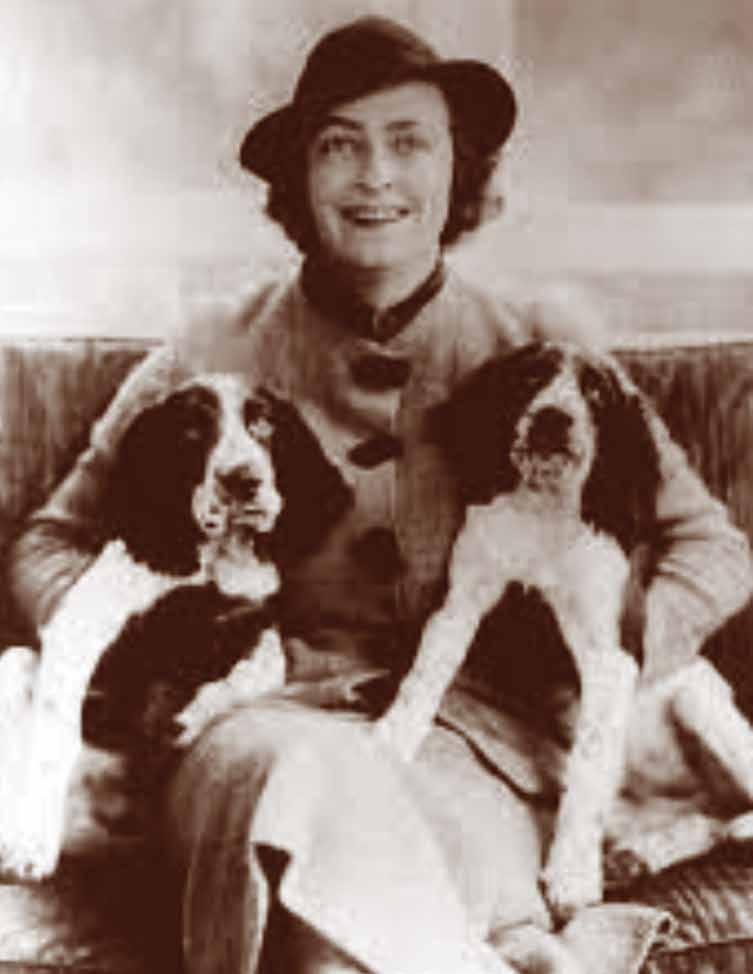
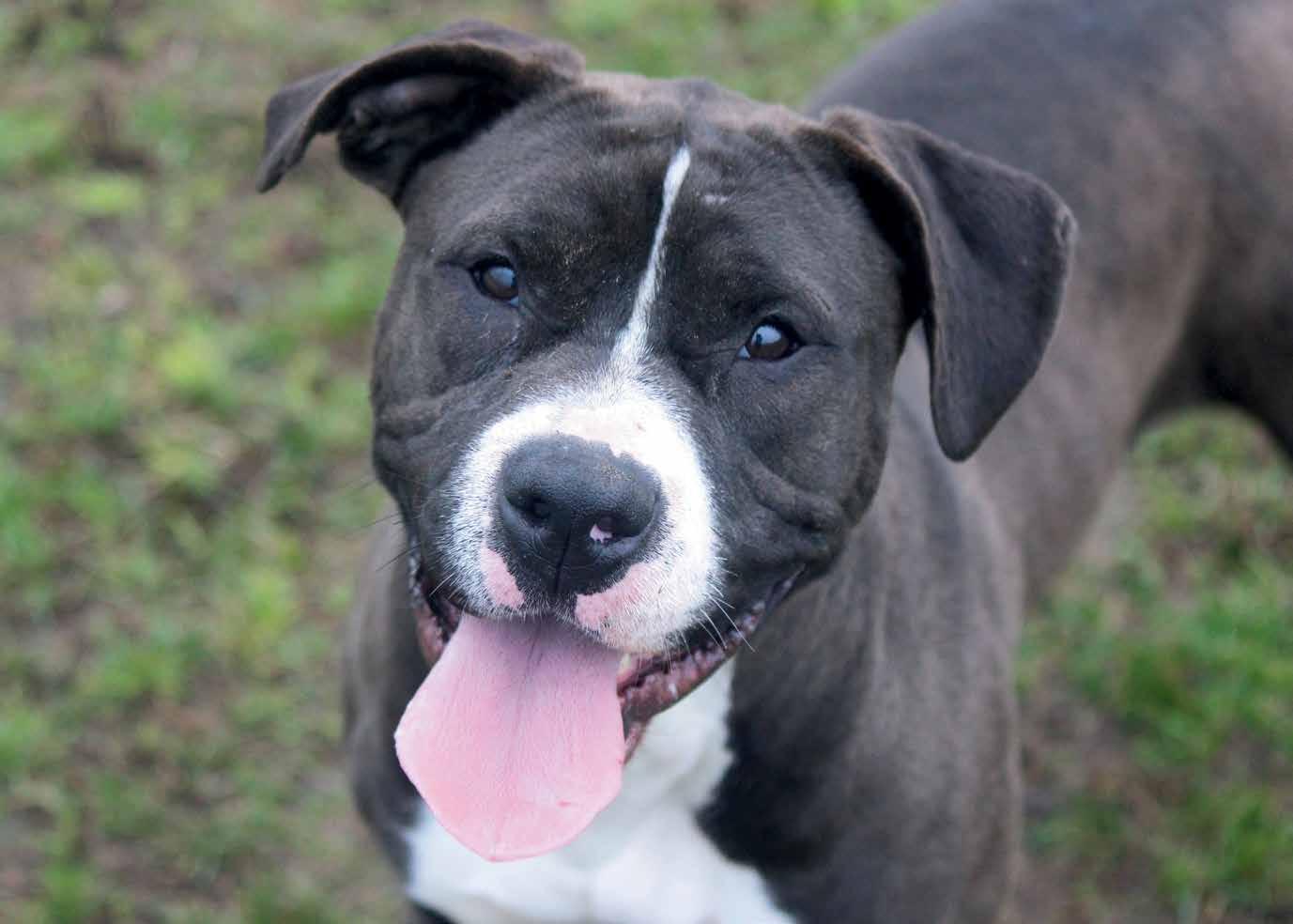
Too often, Pit bulls are misunderstood and shunned because of dogfighting ring operators who illegally use them.
David Tant, once labeled one of the most notorious dogfighters in the United States, was at the center of a harrowing case in 2004 that brought to light the cruel realities of organized dogfighting. His conviction not only revealed a gruesome nationwide network of abuse, but also served as a turning point for animal advocacy in South Carolina. Central to this effort was Charleston Animal Society, which played a pivotal role in sheltering the dogs confiscated from Tant's operation during the years-long legal ordeal.
Tant’s operation came to light after a land surveyor was injured by a booby trap on his property, leading authorities to discover a large-scale dogfighting enterprise. 41 dogs, most of them pit bulls, were found chained in deplorable conditions. They bore scars and injuries consistent with fighting and neglect, underscoring the inhumane treatment they had endured. Authorities also seized caged treadmills, cattle prods, shotguns, and rifles, as well as small explosive devices.
Charleston Animal Society quickly stepped in to address the monumental task of caring for these animals. At a time when resources were stretched thin, the organization mobilized to provide immediate shelter and veterinary care, and they attempted to rehabilitate the dogs. Charleston Animal Society staff and volunteers worked tirelessly to ensure that these animals, many of whom had known nothing but violence, received the compassion and care they desperately needed.
Tant was sentenced to 40 years in prison, a strong statement against his crimes. That sentence was reduced to 30 years after Tant paid $80,000 to the shelter as restitution for taking care of the dogs. His time behind bars was shortened due to his cooperation in other cases and “good behavior,” leading to his release on
parole in 2014. His early release stirred mixed emotions among animal advocates, many of whom felt that the gravity of his crimes warranted his full sentence. Still, Tant’s conviction and the subsequent fallout served as a deterrent and brought attention to the broader issue of animal cruelty.
Charleston Animal Society and South Carolina Attorney General Henry McMaster spoke in opposition to Tant’s parole.
Sadly, all of the dogs were deemed too aggressive to adopt to families and they were humanely euthanized. For Charleston Animal Society, the case was a defining moment that underscored their resolve to combat cruelty to stop anyone before they turn an animal into a killing machine.
As recently as January 2025, dogfighting was still on the radar of state officials. In his statewide address, now Governor McMaster said, “Most folks at the Statehouse, they would say dogfighting is certainly a bad thing, and anything we can do to lessen it or get rid of it all together would be a good thing,” he said.
The Tant case highlighted the need for systemic change in how animal cruelty cases were handled in South Carolina. Charleston Animal Society used the case as a platform to advocate for stronger anti-dogfighting legislation and increased penalties for perpetrators. The organization strongly supported a dogfighting task force started by McMaster. Charleston Animal Society’s efforts contributed to raising public awareness about the brutal realities of dogfighting and the importance of supporting rescue and rehabilitation initiatives.
In his textbook Companion Animals in Society , Stephen Zawistowski tracks the development of the American animal shelter movement.
The history of animal sheltering reflects societal shifts in attitudes towards animals, from practical considerations to an emphasis on humane care and protection. Emerging from municipal efforts to manage stray livestock, the evolution of sheltering has been shaped by both necessity and compassion.
Animal sheltering originated in colonial America, where towns established impounds to contain stray livestock. “Poundmasters” captured wandering cattle, pigs, and goats, holding them until their owners paid redemption fees. Unclaimed animals were sold, slaughtered, or retained for meat. While dogs and cats occasionally ended up in these impounds, their limited utility and lack of cultural acceptance as food led to their disposal in crude ways, such as drowning or clubbing.
As towns transformed into cities during the 19th century, livestock ownership diminished, but the number of stray dogs and cats surged. The lack of systematic care for these animals exacerbated the issue. Unclaimed dogs were frequently drowned en masse, and public health concerns, including rabies outbreaks, prompted drastic measures. Cities like Cleveland introduced dog licensing, while in the western United States strays were often shot to reduce their numbers. The plight of urban animals began receiving attention through figures like Henry Bergh, who founded the ASPCA in 1866. Initially focused on horses, Bergh later addressed the inhumane treatment of stray dogs and cats in New York City pounds. In Philadelphia, Carolyn Earle White pioneered the first humane shelter in the U.S. through the Women’s Auxiliary of the Pennsylvania SPCA. They provided food, care, and adoption opportunities for stray animals, introducing a more humane approach (for the time) to euthanasia using gas chambers. White's initiative laid the
foundation for a broader movement toward humane animal sheltering.
By the late 19th century, cities began adopting humane sheltering practices. In 1894, the ASPCA assumed control of the New York City pound, introducing gas asphyxiation to replace drowning and expanding their efforts to include cats. The South Carolina SPCA began to push for a gas chamber in the early 1900s. Over time, SPCAs and Humane Societies across the country took on the dual roles of providing care for stray animals and addressing public health concerns. The term “Humane Society” gained prominence, reflecting the broader mission of humane treatment for both animals and, historically, children.
It wasn't until the 1960s that the scale of euthanasia became a pressing concern. Advocates like Phyllis Wright from the Humane Society of the United States championed a three-pronged strategy: sterilization, education, and legislation. Spaying and neutering were promoted as essential to reducing the population of unwanted animals. By the 1970s, shelters phased out inhumane euthanasia methods in favor of sodium pentobarbital injections.
Animal shelters serve dual purposes: providing humane care for homeless animals and protecting public health. Communities employ varied models to manage these needs, from government-run shelters to partnerships with humane organizations. Funding sources include adoption fees, fines, and private donations, but financial constraints often limit the scope of services. The modern animal sheltering system remains fragmented, shaped by historical practices and local needs. While significant progress has been made in humane treatment, ongoing efforts are required to address overpopulation, improve shelter conditions, and promote responsible pet ownership.
Thirty-four cats were rescued from a North Charleston hotel room and brought to Charleston Animal Society for treatment and adoption in 2021.
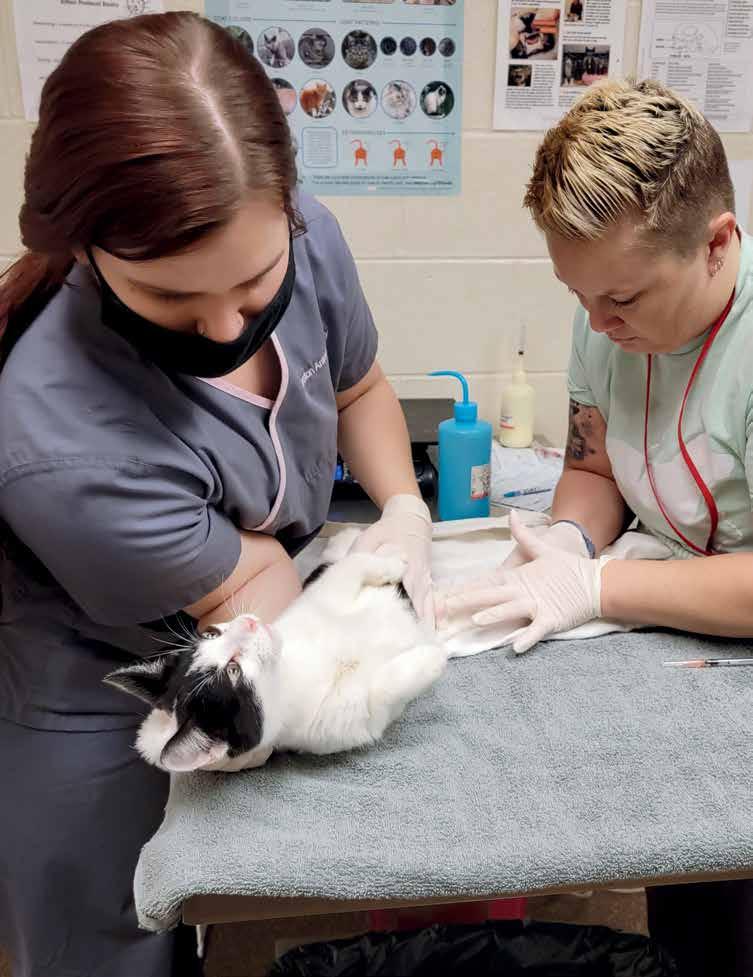
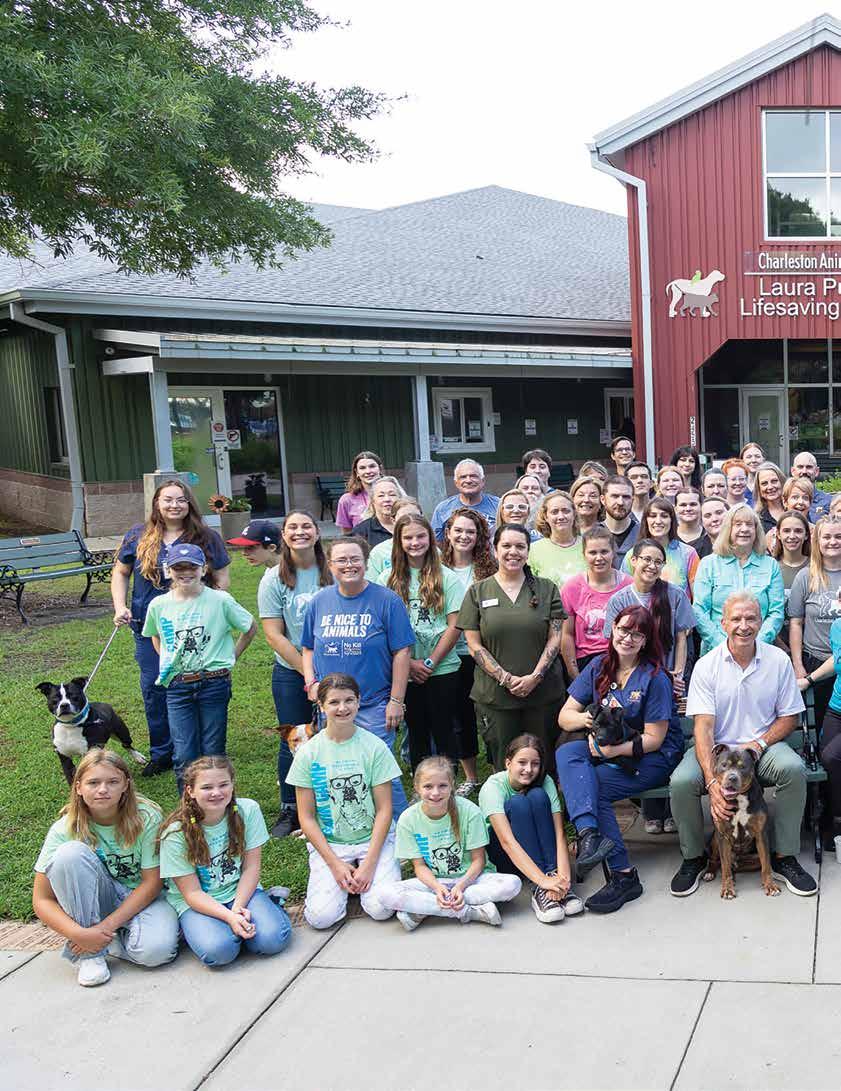
1874
SC Legislature charters the South Carolina Society for the Prevention of Cruelty to Animals (SCSPCA)
1891
The organization lobbies the state legislature to allow the SCSPCA to handle child abuse cases
1880
First meeting of SCSPCA draws 40 people, officers are elected, and a constitution is drawn up
1910 Society purchases water fountains for horses and other animals to place around city
1900
Second SCSPCA President, John Ancrum, dies, leaves his estate to the Society, requiring it be named for him
1894
First “special detective” hired by SCSPCA to root out animal cruelty
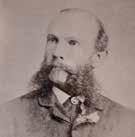
1913
After years of conversation, the Society convinces the City to stop shooting dogs
1932
Mrs. Julia Gordon is elected as the first female President of the SCSPCA. Her generosity kept the organization afloat during the Great Depression.
1940
John Ancrum’s inheritance goes to the animals after his last survivor dies; SCSPCA renamed John Ancrum SPCA
1945
Margaret Waring leads a group of young, enthusiastic animal lovers to join the organization; she is later elected president in 1960
1948
The first shelter in the organization’s history (120 sq ft) is built at 667 Meeting Street
1951
1964
With John Ancrum SPCA support, The American Humane Association held its national convention at the Francis Marion Hotel in Charleston, with 300 people in attendance
A new shelter is built at 188 St. Andrew’s Boulevard after quickly outgrowing their downtown location
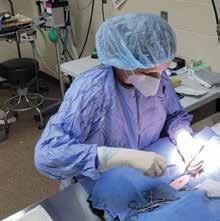
1993
The organization begins spay-neuter surgeries on animals who were adopted
1948
The original minute book of the John Ancrum SPCA along with other historic archives are turned over to the South Carolina Historical Society for safekeeping
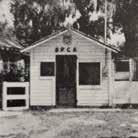
1961
The shelter moves to a new location at 820 Dupont Road in West Ashley
1980
The Society moves to a new shelter at 3861 Leeds Avenue in North Charleston
Charleston County closes its dog pound and enters into a contract for services with the John Ancrum SPCA
1983
The shelter launches an annual SPCA Day that gets publicity for the animals in need
1947
The John Ancrum SPCA gets a highly publicized cruelty conviction for “gander pulling”
Dozens of fighting dogs brought to the Society after a surveyor is shot in leg by a booby trap on Charleston County property owned by David Tant, who was sentenced to 30 years in prison. Tant is regarded as one of the most notorious fighting dog breeders
Charleston Animal Society’s Humane Education program is formalized
Charleston Animal Society earns top-rated nonprofit by charity watchdog organizations among over 30,000 nonprofits in South Carolina and sustains its #1 ranking to date
Charleston Animal Society launches the Free Roaming Cat initiative to spayneuter feral cats
The organization’s first spayneuter clinic for the public opens in a West Ashley Super Pets store
The name of the organization is changed to Charleston Animal Society
The current animal care campus opens at 2455 Remount Road in North Charleston
Under the advocacy of ASPCA Board Member, Elizabeth Bradham, Charleston County was among a handful of counties selected to participate in a nationwide initiative to improve live release rates
Charleston County becomes the first No Kill Community in the Southeast under the leadership of Charleston Animal Society, years ahead of expectations
Efforts to restrict nonprofits and government agencies from providing veterinary care services to the public met with fierce opposition over a four-year fight in the legislature
The outreach program Pets for Life begins at Charleston Animal Society, focusing on urban communities, it would go on to win the HSUS “best program in the US” honors
Charleston Animal Society is a founding member of the South Carolina Animal Legislative Coalition
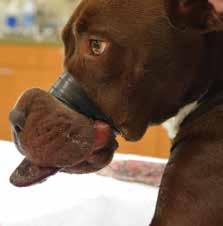
Charleston Animal Society becomes the first combined animal hospital-shelter in the South to achieve the coveted American Animal Hospital Association (AAHA) accreditation
The case of Caitlyn the dog goes viral launching international attention on animal cruelty, she was found with her muzzle taped shut in North Charleston
Blondie the horse collapses pulling a carriage downtown and ignites years of pleas for the City of Charleston to reform its carriage policies
Charleston Animal Society's famous Chili Cook-off event exceeds 6,000 participants and is the largest animal-related event in South Carolina
Charleston Animal Society launches the groundbreaking No Kill South Carolina statewide initiative to build a No Kill State, funded by Petco Love
Charleston Animal Society establishes the Elizabeth Bradham Humanitarian Award recognizing individuals who have made significant impacts alleviating the suffering of animals
Pounce Cat Café opens in Charleston, exclusively offering Charleston Animal Society felines for adoption
Helping Hands for Rural Paws expands the Society’s outreach program to rural areas
The first Pick Me! SC Statewide Adoption Event is organized by No Kill South Carolina, more than 12,000 animals have been adopted since its launch, sponsored by Petco Love and BOBS from Skechers
Charleston Animal Society receives the state Better Business Bureau Torch Award for transparency and ethics
Judge rules for Charleston Animal Society in pivotal case brought by carriage industry that attempted to stifle the Society’s animal advocacy through a SLAP lawsuit
A Charleston entrepreneur introduces an electric carriage that could be an alternative for tourists, City officials don’t welcome the idea
Charleston Animal Society celebrates 150 years of its legacy of care Flag flown over U.S. Capitol in honor of the Society's Sesquicentennial Former Board Chairs Hank and Laurel Greer receive the Order of the Palmetto, South Carolina's highest civilian honor NKSC: mission accomplished
Using key strategies, Charleston Animal Society remains open throughout the global Pandemic, adoptions soar as pets help cure loneliness from isolation
The Simon Greer Mobile Spay Neuter Clinic is donated by Hank and Laurel Greer to Charleston Animal Society
Funded by Maddie’s Fund, Charleston Animal Society offers national seminars and apprenticeships to share lifesaving strategies on a national level
Charleston Animal Society leads nation with the most Certified Animal Welfare Administrators and continues to hold the record to date
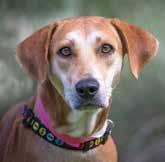
Charleston Animal Society’s VAX-A-PALOOZA sets a Guinness World Record
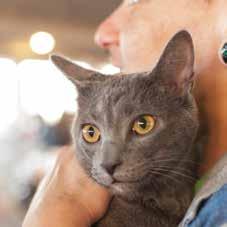

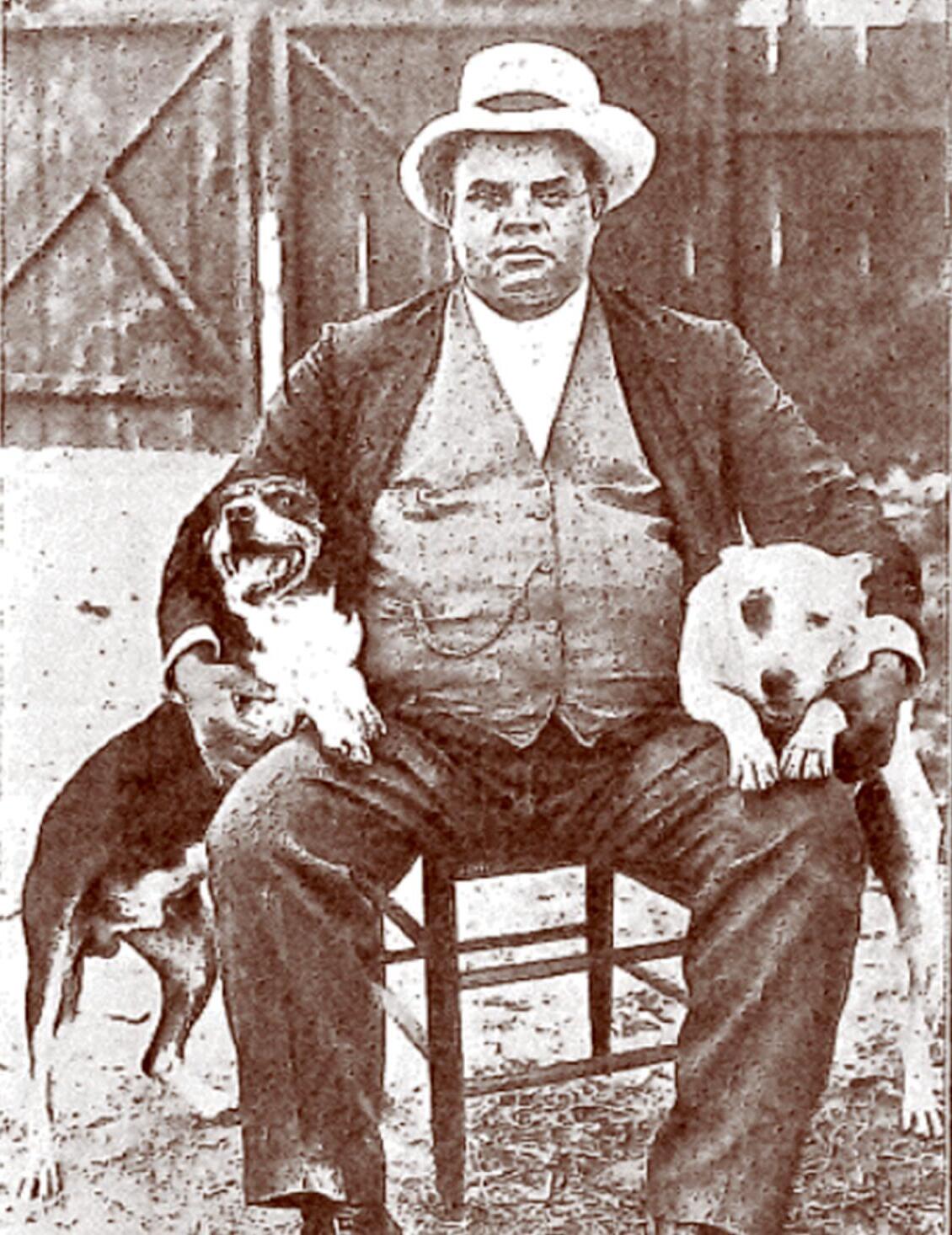
“Glory
to God, Peace on Earth, Kindness, Justice and Mercy to Every Living Creature.” – Motto of the American Humane Education Society
BY EMMA GLEAVE
Cambridge University
Ph.D. Candidate
Within years of Charleston Animal Society's launch, its founders recognized the need to reach children through humane education. In 1911, President Alwyn Ball said at the organization’s annual meeting, “As the principal object of all humane societies is to prevent cruelty, let us properly educate and instill into the minds of our children at home and in the schools, the love for the poor beasts in the years to come not only in Charleston, but in all cities, and we will be rid of the great amount of cruelty which now exists.”
One man who took this to heart was Reverend Richard Carroll (1859 – 1929). Carroll was one of six American Humane Education Society (AHES) field workers. In July 1919, on one of his many speaking tours, he noticed that every afternoon when he gave his humane lecture about animal suffering in the city of Woodruff (near Greenville), a big shepherd dog would come and lie in front of him and remain there for the duration of the talk! His owner was nowhere to be seen. Carroll used an organ that was transported by truck to attract the crowds. Perhaps the organ’s noise also alerted the dog to the start of Carroll’s lectures!
Carroll was born enslaved in Barnwell County. He did not know the identity of his white father, and his Black enslaved mother died while he was a child. After a difficult childhood toiling on the land, Carroll resolved to work his way through Columbia’s Benedict Institute. In The State newspaper’s May 15, 1904 issue, Carroll
relates how no work was available unless the college staff told him he could milk a particular “unruly cow.” Carroll accepted the challenge and prayed to God for help. Fortunately, the cow liked him and allowed Carroll to milk her. He would later laughingly remark, “I milked my way through college.” Clearly, Carroll had a way with animals.
After college, Carroll became a powerful preacher in the Baptist Church and one of the most influential African Americans in South Carolina in the early twentieth century. He set up a school for African American boys and, on its closure in 1907, sponsored an annual conference on race. In 1913, Carroll became a very active and well-respected field worker for the AHES. The AHES partnered with the Massachusetts Society for the Prevention of Cruelty to Animals.
The publication Our Dumb Animals carried many flattering articles about Carroll’s skills in attracting people to his humane lectures about kindness to animals, his great eloquence in support of animal education, and his ability to hold an audience’s attention. The 1813 annual report of the AHES noted that Carroll had lectured before schools, churches, institutes, and state universities throughout the South and West, including Virginia, Kentucky, Arizona, and Texas.
The motto of the American Humane Education Society was “Glory to God, Peace on Earth, Kindness, Justice and Mercy to Every Living Creature,” and Carroll exemplified these values.
BY RAINEY EVANS
Hosted the “Happy Raine” Children’s Show
In 1960 I was tapped to do a Children’s TV program on Channel 5. The “Happy Raine Show” entertained generations of children over a 20-year run. In each broadcast I played a Native American princess who took children on marvelous, educational adventures that expanded their imaginations. Many episodes included animals from what was then called the “John Ancrum SPCA.”
My colleague at Channel 5 was Carroll Godwin who did a midday show with invited guests. Weekly he included someone from the shelter who usually brought dogs available for adoption. So many lives were saved, including a party poodle I adopted named Dolly who would do anything for a Dorito, including jumping through a hoop!
As Charleston Animal Society turns 150 years old, it is fascinating to think how many lives TV and radio appearances have helped save. There were all of the animals that appeared while I was on the air. And since the 1990s, I have watched Charleston Animal Society’s Kay Hyman bring animals to every TV and radio station in the Lowcountry including Channel 5, Channel 4, FOX 24, and Channel 2.
It’s equally amazing that those who started the organization knew how important the media was to saving animals. In 1910, the Board of Directors lobbied the Post and Courier to let children send in essays about animals. The organization also set up a committee to “do Press work” to keep the plight of animals in the news. Headlines about the organization go as far back as 1874!
My broadcast career propelled me into situations and adventures I had never even imagined! I’d journey to Walterboro for parades where I rode horseback. My
co-star on “Happy Raine” was an orphaned raccoon, who I often took home after work with his harness attached to the gearshift in my Austin Healey Sprite. Coonie would plop himself on my shoulders and we’d drive along with the top down.
Lassie the famous TV Collie visited my show and one time in Los Angeles on a promotions tour, I was seated beside Benji from the movies.
I have always believed that when you are loved by an animal, you better hope the feeling is mutual because you have been given a priceless gift. My life has been blessed by a veritable menagerie of animals large and small. Growing up, there was a Persian cat named Felix, a cocker spaniel named Roy, and my Daddy’s hunting dogs, Nancy and Nellie. As an adult, there was Dolly and a succession of cats like Tut, Baby, and Sufi.
There are many ways a person can make a difference in this world, but there is hardly any that can match caring for our animal friends. I feel blessed to have played a role in saving so many animals along with all of my media colleagues throughout Charleston Animal Society’s 150-year legacy of care.
Rainey Evans as “Happy Raine” with Lassie on the Channel 5 children’s show that aired from 1960-1980 and often promoted animals.
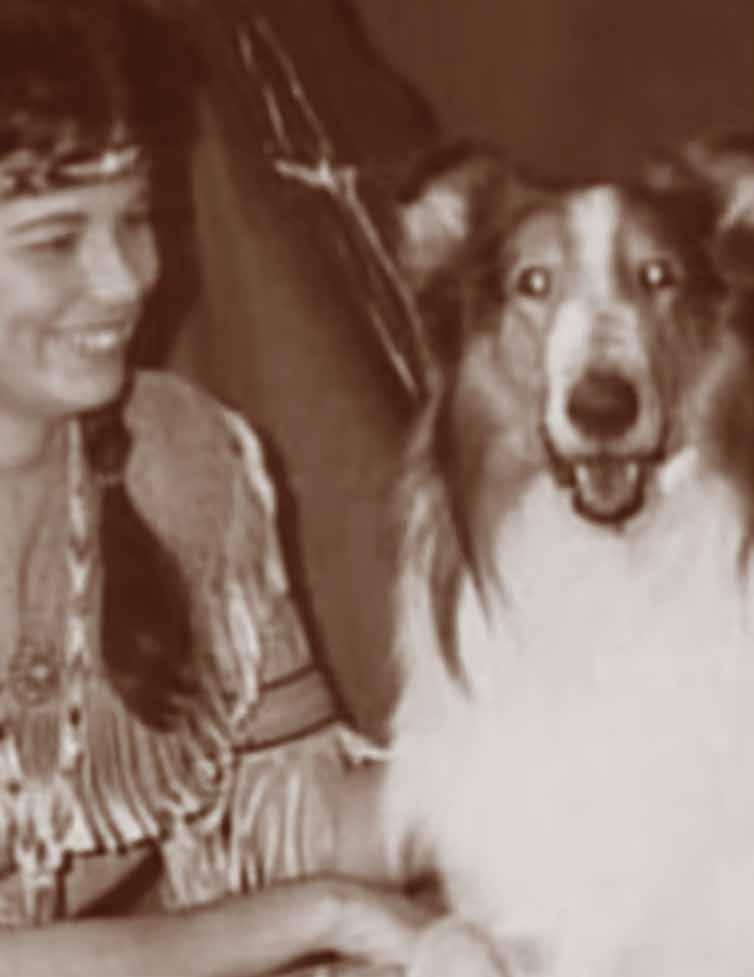
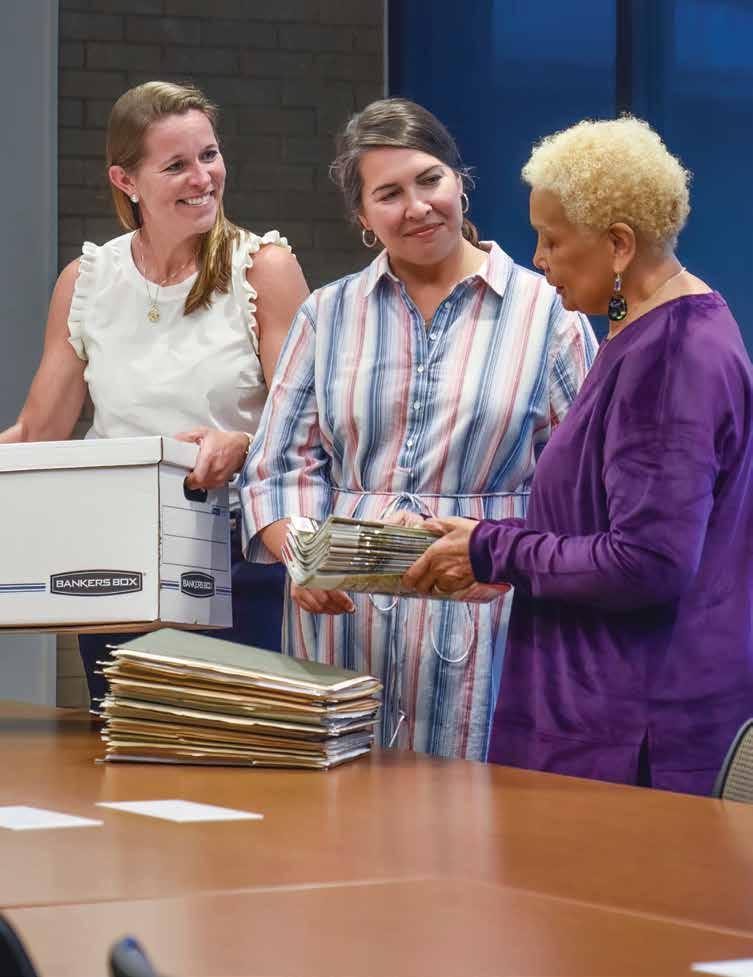
BY
Sesquicentennial Committee Co-Chairs Patricia Henley (r) and Jane Graham (l) present COO and Director of Collections at the South Carolina Historical Society Virginia Ellison with archives from Charleston Animal Society history.
BY VIRGINIA L. ELLISON, MLIS, CA, DAS
South Carolina Historical Society Chief Operating Officer and Director of Collections
As the first Society for the Prevention of Cruelty to Animals in South Carolina, the leadership of the organization recognized their impact was important and that the Animal Society’s story needed to be preserved — by another society. In 1955, Mrs. Louis M. Gourd, the vice president at that time, donated the original minute book of the organization, dating from 1880 to 1914, to the South Carolina Historical Society (SCHS), the steward of South Carolina’s largest and oldest private manuscript collection.
The first entry in the minute book was written by J. Alwyn Ball, the Animal Society’s secretary at that time, who recorded, in his impeccable penmanship, the elected officers present at the meeting on June 16, 1880 and the various committees. He refers to “a call published in the News & Courier June 9th inviting a meeting for the formation of a Society for the Prevention of Cruelty to Animals” and adds “between thirty and forty citizens including many ladies, assembled at the South Carolina Hall.”
The SCHS also holds the family papers of many of those listed throughout the SCSPCA collection such as the Balls, Middletons, and Pinckneys. In addition, researchers can access the original estate records of John Ancrum’s will where he leaves the bulk of his fortune to the SCSPCA.
Since its founding in 1855, the SCHS, a registered 501(c)(3), has been the guardian of South Carolina’s written past. The organization’s manuscript collection spans the entire range of this state’s history, from its
colonization in the 1670s to the present. It grows constantly, and has become an invaluable resource for students, scholars, authors, genealogists, historians, and others who are interested in South Carolina history.
Strengths of the collection include the periods of the American Revolution, the antebellum period, the American Civil War, and the Charleston Renaissance (1930s to 1940s). Currently, the SCHS has over three thousand manuscript collections that include letters, diaries, and legal papers; more than ten thousand oversized plats, maps, and drawings from architecture, engineering, and landscape firms; and more than 30,000 photographs, prints, and other visual items. This collection includes the papers of thousands of individuals and families, as well as the records of numerous organizations, businesses, and churches. These are unique items that cannot be found elsewhere and provide valuable insight into all aspects of the history of South Carolina.
These collections are accessible to the public Monday through Friday in the South Carolina Historical Society’s Reading Room, located on the third floor of the College of Charleston’s Addlestone Library (205 Calhoun Street) in downtown Charleston. All archival collections are located here where they are housed in acid-free records cartons and folders and stored in climate-controlled vaults with a sophisticated system for monitoring temperature and relative humidity to ensure their preservation for future generations.
The public can also visit the South Carolina Historical Society Museum in Charleston (100 Meeting St.); that features interactive exhibits on the people, places, and movements that shaped the state and nation. For more information, visit www.schistory.org.
BY ELIZABETH BRADHAM Charleston Animal Society Former Board President
The year 2013 was a critical time for Charleston Animal Society. We decided to change the way domestic animals were viewed and treated in our community — permanently. We first looked at some of our own behaviors, such as common sayings used by all of us — for example, “kill two birds with one stone,” “don’t let the cat out of the bag,” and “don’t have a dog in that fight.” We needed to be more mindful and eradicate any language that condoned harm and violence to animals. And with the help and guidance of the American Society for the Prevention of Cruelty to Animals (ASPCA), the Humane Society of the United States (HSUS), and PetSmart Charities, we committed ourselves and the community to becoming No Kill by 2015.
In other words, we made a paradigm shift in our community’s relationship with animals. It would no longer be acceptable for healthy, adoptable animals to be euthanized for lack of a home.
When you think about our history with dogs and cats, one that goes back over 15,000 years, perhaps even 30,000 years, our best friends are also our oldest friends. Their domestication allowed humans to hunt more effectively, to store grains long term as a safeguard against bad crop years and famine, and to have effective sentries against predators. Today, dogs and cats still perform these very same tasks. The human/canine and human/feline bond is unparalleled in the animal kingdom. No other two species share this ancient, interrelated history.
In fact, we often spend more time with our family pets than we do with our human family members, because they are always there at home with us — not going to work or school, sports, or recreation. Their lives revolve around us and our shared home. And yet, the biggest mortality factor for either a cat or a dog is homelessness — not cancer or heart disease — homelessness. It seemed so simple — can’t we just find good homes for those in need of one? So we decided in 2013 to do just that. We would do our utmost to eliminate the risk of homelessness for the dogs and cats in our community.
With the help of our friends at the ASPCA, HSUS, and PetSmart, we embarked on a program of highvolume spay-neuter. We needed to turn off the faucet. We also began multi-pronged programs of outreach, communication, adoption, fostering, and more. The creation of a food bank helped families provide for their pets when times were tough. The Pets for Life program helped families keep their pets in their home by sometimes providing something very simple — such as a fence — allowing safe outdoor space for dogs.
And while we achieved our No Kill Charleston goal two years ahead of time, we still had much to do. We need to assist other communities in our state to raise the level of care for all animals in South Carolina, so that they can have the same prospects for a happy and healthy life as those who live in Charleston County.
After acheiving No Kill Charleston, the Board of Directors adopted a guiding principle tied to our original constitution, that if there is an animal in need anywhere and we can help that animal, we will. We then announced No Kill South Carolina in 2015 (see page 66)
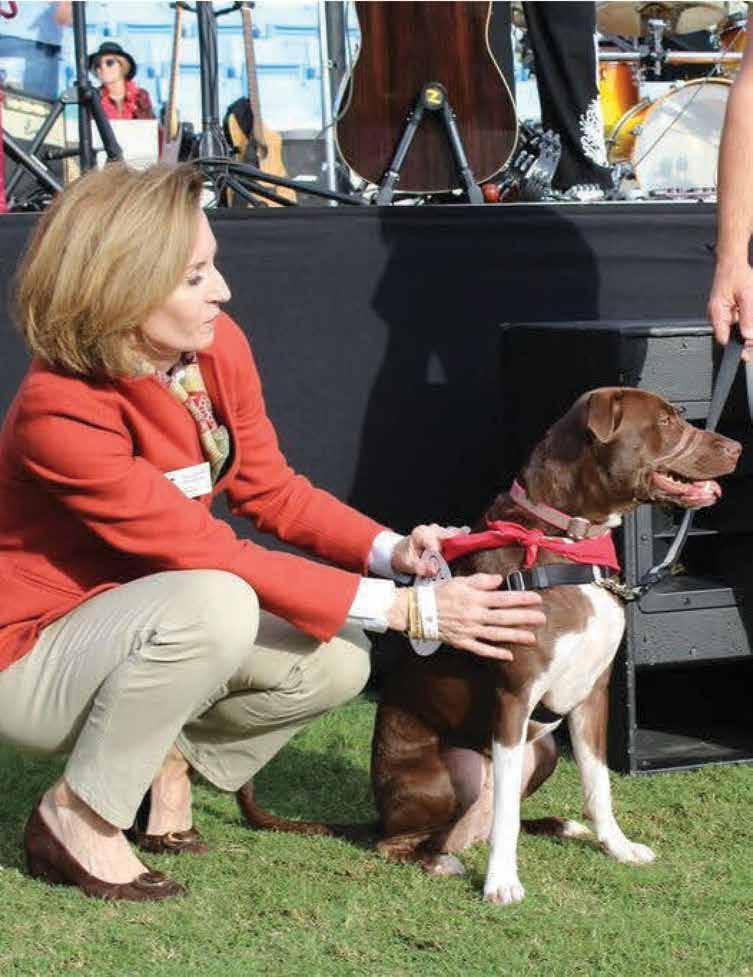
In 2015 Caitlyn became the face of cruelty around the world after she was found with her muzzle taped shut.
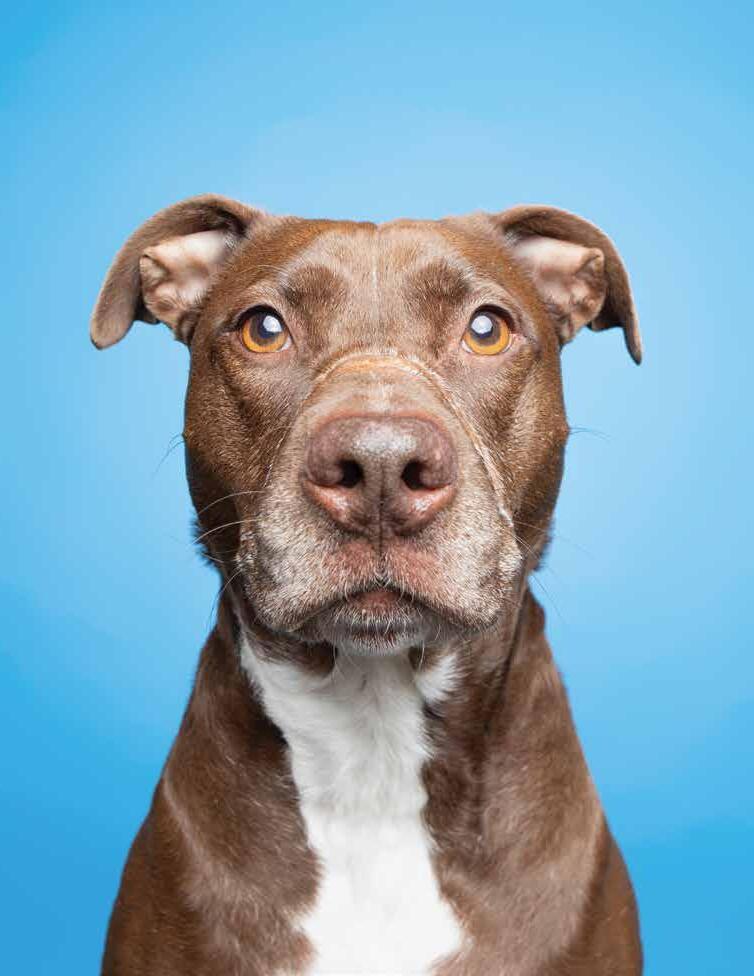
BY GREG
BY ALDWIN ROMAN, CAWA
Charleston Animal Society Vice President & Chief Operating Officer
When considering Charleston Animal Society’s 150 year history, the story of Caitlyn may seem like a blip. In a sense she was just one animal out of hundreds of thousands that the Animal Society has helped over its history. But Caitlyn represents more than just one animal. She is a reminder of the terrible things that are done to animals, but also a reminder of what can be accomplished when a community rallies together to stamp out cruelty.
“I’ve never seen anything like this …” It all started with a call in the early morning of May 27th, 2015. Normally, I would have told the officer to bring the animal to the shelter and we could do whatever was needed. But this time, the officer, a veteran on the force, sounded shaken. She wanted me to come to the scene right away.
When I arrived, she asked me to look into the back of her truck. That’s where Caitlyn stood the very first time I saw her. It was still morning and the sun wasn’t fully out, but I could see her eyes, beautiful and golden, almost pleading. And just below was a shocking sight, her muzzle was taped shut with tightly-wound electrical tape.
Taking pictures was part of my job. Capturing every detail, every inch of animal abuse victims to help officers, prosecutors, and the courts understand animal cruelty. In those early moments in this case, it was quiet in Charleston Animal Society’s medical treatment room. We were all in shock. The truth is, at that point, we really weren’t sure Caitlyn would survive. The electrical tape had kept her from eating or drinking. Her snout was severely swollen and even breathing was difficult.
Caitlyn’s recovery took a monumental effort from veterinarians at the shelter and across Charleston. From initial treatment, to laser therapy, and hyperbaric chamber treatments, Caitlyn received the best care possible.
Along with lifesaving care, we knew Caitlyn also needed justice. Someone knew what happened. We released photos of her staring directly into the camera as she fought for her life.
I never imagined that her story and her picture would resonate so strongly. The calls and emails trickled in at first, but then it kept growing and growing, going viral across social media. By the time I started getting emails from Italy, Caitlyn had become the ambassador for animal cruelty victims across the globe. Her scar across her muzzle had become a symbol of strength. Her story was a rallying call for communities everywhere who said “Enough is enough” and wanted an end to animal abuse. Caitlyn’s abuser was prosecuted and sentenced to 15 years in prison. He faced more time when authorities found probation violations.
When the courtroom ordeal ended, the prosecutor on her case, Ted Corvey, III adopted Caitlyn, making her happy ending complete. The adoption meant she could live out the rest of her life with her hero — happy, secure, and free from harm. Exactly what every dog deserves.
Caitlyn lived until January 12, 2025 with Ted, his wife Danielle, their son Regin, and their two dogs Sullivan and Penny. A candlelight vigil at Charleston Animal Socieety fondly remembered Caitlyn and other victims of animal abuse in February 2025.
BY DR. LUCY FULLER Charleston Animal Society Chief Veterinary Officer
Walk into Charleston Animal Society and you will find two modern surgery suites dedicated to high-volume, high-quality spays and neuters. The Sam Greer SpayNeuter Clinic performs more than 15,000 surgeries each year. From offering low-cost surgeries to the public, a robust Trap-Vaccinate-AlterReturn (TVAR) program, and spay-neuter services for shelter animals in Charleston and across the state, providing the highest quality of care is paramount.
In an era where there is a statewide and national veterinary shortage, Charleston Animal Society employs three full-time veterinarians dedicated to the mission of ending dog and cat overpopulation through surgeries that prevent the births of unwanted animals. This work is supported by veterinarians around the community.
It’s light years from the organization’s first steps into spay-neuter that began in the 1990s in a single-wide trailer at the Animal Society’s Leeds Avenue location. In 1997, the shelter’s first public spay-neuter clinic opened in a SuperPets store in West Ashley. In 2024, Charleston Animal Society completed 15,406 spayneuter surgeries, setting a new internal record.
Charleston Animal Society takes pride in a legacy of care for animals, and the shared values of leadership, tradition, and excellence. So when the opportunity arose for the Sam Greer Spay-Neuter Clinic to become an American Animal Hospital Association (AAHA) accredited facility, there was no doubt the organization would work to achieve that, ensuring that the clinic delivers the highest quality of care to shelter and public animals.
According to AAHA, only about 15% of all veterinary
practices in North America successfully achieve this milestone. In 2015, Charleston Animal Society achieved that accreditation, and became one of the first shelter-clinic facilities in the south to do so, maintaining that accreditation ever since.
“I have enjoyed having this as a benchmark because it keeps us operating at a level that makes me proud,” said Charleston Animal Society President & CEO Joe Elmore, CAWA, CFRE. “I know we cannot let our standards slip, because I want to ensure we hold to what we have promised our customers and supporters with the accreditation.”
AAHA is dedicated to helping veterinary practices achieve excellence, and provides a variety of resources to both veterinary professionals and pet owners.
In the mission to end animal cruelty and overpopulation, Charleston Animal Society has always recognized prevention as the key to success. In 2017, Hank and Laurel Greer generously donated a stateof-the-art mobile spay-neuter clinic named for their beloved cat Simon.
This rig has traveled more than 5,000 miles to every region of South Carolina performing spay-neuter surgeries before major adoption campaigns, after hoarding cases, and for other emergencies. Inside are two surgery tables and a prep area design that rivals most regular clinics.
Spay-neuter has been a key strategy as Charleston Animal Society continues to work passionately to save every healthy and treatable animal in the Lowcountry and help other shelters across the state do the same for their communities.
The Sam Greer Spay-Neuter Clinic performed more than 15,000 surgeries in 2024.
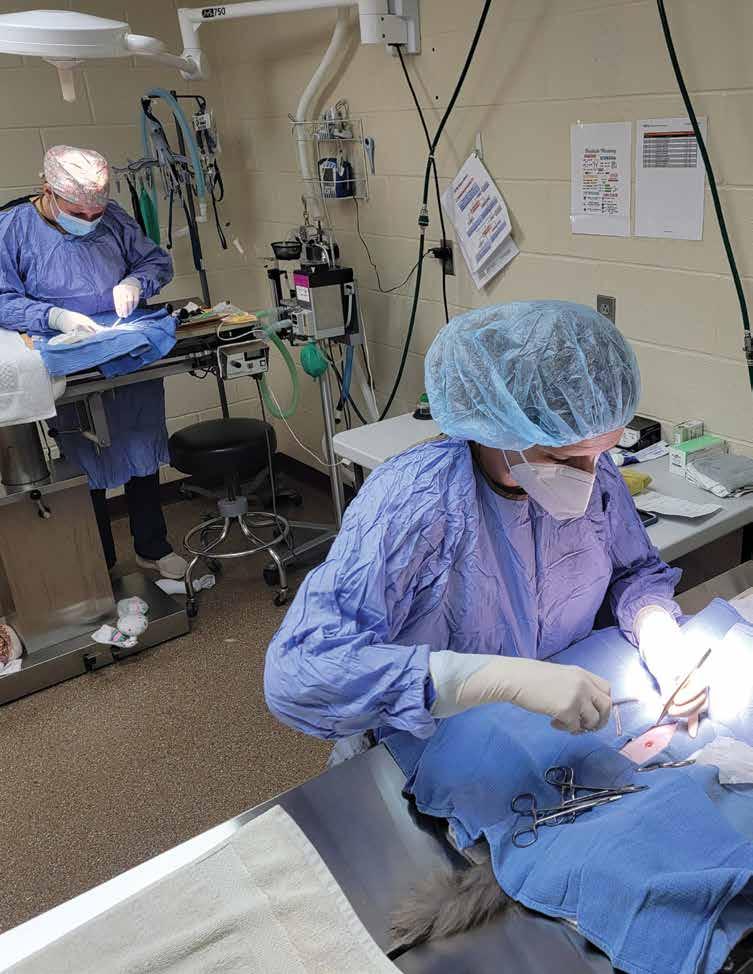
Louie the three-legged labrador was an inspiration to thousands of children in classrooms since 2011.

BY DE DALTORIO Charleston Animal Society Chief Education Officer
Since its inception, Charleston Animal Society has understood the transformative power of humane education in nurturing compassionate citizens. At a 1901 board meeting, Board President Alwyn Ball passionately urged teachers to join the cause, saying, “Just think what great work could be done by them among the young boys and girls under their care by influencing them in their humanity towards the dumb brute, our noble friends through life.”
In 2003, a visionary teacher answered President Ball’s call. Ann Ellison, a former special education teacher, formalized Charleston Animal Society’s humane education program. From these humble beginnings, the program has surged ahead, delivering a record-breaking 34,000 lessons to 11,600 students across 89 schools in 2024.
Beyond the classroom, the program extends its reach through summer camps at the shelter, where hundreds of children learn about animal behavior, create adoption posters, and write advocacy letters to lawmakers. These camps are filled with compassion, where young minds are shaped to see kindness as a powerful tool for change.
In a world where empathy seems increasingly scarce, where headlines scream of cruelty and indifference, humane education shines as a beacon of hope. It’s not just about teaching kids to be kind to animals; it’s about instilling a mindset of compassion that permeates every aspect of their lives. Humane education plants seeds of empathy that will one day blossom into a more humane society.
Studies have shown that children who participate in humane education programs exhibit higher levels of empathy, compassion, and social behavior. They are more likely to stand up for others, volunteer in their communities, and become leaders for positive change.
Consider Kailey, who at 11 years old attended Charleston Animal Society’s summer camp. She became a youth volunteer, graduated from the teen leadership program, and is now pursuing higher education while continuing to advocate for animal rights.
Then there’s Lauren, a former program participant who went on to Clemson University with dreams of becoming a veterinarian. These stories are testaments to the program’s profound impact on young lives.
Charleston Animal Society’s Humane Education program is nationally recognized. Between 2020 and 2024, the entire three-person department took on leadership roles at one point or another in the national Association of Professional Humane Educators. The team developed the first-ever humane education apprenticeship, teaching the course to shelter professionals around the country.
As we reflect on the past and look to the future, it is comforting to know that the Animal Society’s commitment to humane education is a key component to ensuring that every child has the opportunity to learn and grow in a world filled with kindness, empathy, and compassion.
2024 SNAPSHOT: 34,384 Compassion Lessons 11,671 Children Reached 89 Schools
BY DAN KROSSE Editor-in-Chief
It was a long way to go for a dog rescued from a puppy mill operation in Pickens County by Charleston Animal Society just two years eariler.
But in the summer of 2024, Boo became the official “ambassadog” to Washington for the Society.
The mission for this strapping, 85-pound GreatPyrenees mix? To put a face on Charleston Animal Society for the South Carolina Congressional delegation. Boo was there to help tell the organization’s story and explain why the Society needed money for a historic campus expansion.
Everywhere Boo went during his two-day visit in late July, people came out of their congressional offices to see him. Whether he was meeting with Senator Lindsey Graham, Senator Tim Scott, Congressman Jim Clyburn’s office, or Representative Nancy Mace, Boo did us proud.
Coinciding with the visit, a flag flew over the Capitol in honor of Charleston Animal Society’s 150th Anniversary. In November of 2024, that same flag was presented to those attending Charleston Animal Society’s Paws in the Park festival.
While on the Hill, Boo was also a hit with business partners. At the South Carolina Business Council meeting and at the Prayer Breakfast meeting, representatives from BMW insisted on photos and even sharing a table with Boo.
Another big hit during the Washington visit were the Boo and Sam Greer baseball cards, which were handed out across the Capitol to help keep Charleston Animal Society top of mind in the future.
“This trip was incredible. To have Boo there to help us share our message was perfect,” said Charleston Animal Society Board Member Laurel Greer.
Greer, along with husband and fellow Board Member Hank Greer, Charleston Animal Society President and CEO Joe Elmore, Charleston Animal Society Digital Marketing Manager Will Howell, and Political Strategist Pat Votava, escorted Boo to all of his meetings.
Boo was one of 166 dogs rescued by Charleston Animal Society and other rescue organizations from a puppy mill in Pickens County in 2022. Many of the dogs were brought back to Charleston Animal Society for medical treatment and were adopted. Boo was fostered and adopted by Charleston Animal Society President and CEO Joe Elmore.
Since the beginning of Charleston Animal Society, putting animals in the spotlight has been a key part of the organization’s success. Countless animals have appeared in news stories, advertising, TV appearances and at public events to raise awareness for important issues such as adoption, spay-neuter and cruelty.
As for Boo, his mission will take animals into the next 150 years of Charleston Animal Society’s history, now that lawmakers know how the organization’s work benefits families throughout all 46 counties of our state.
Boo proudly represented Charleston Animal Society at the US Capitol in the summer of 2024.
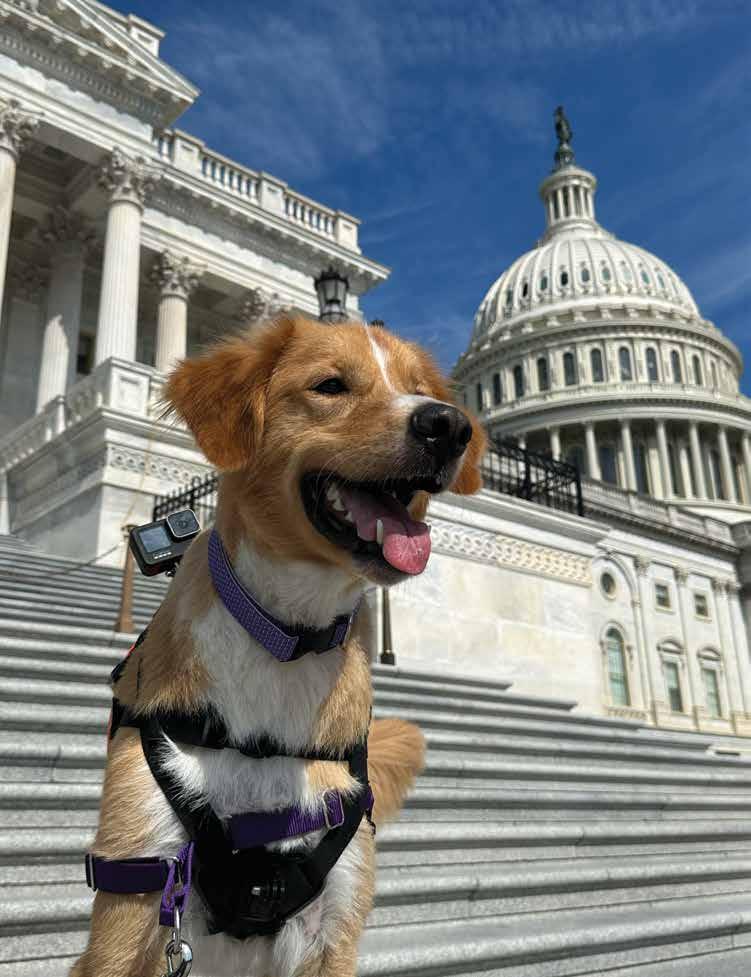
Ava Hart (2019) and her entire family helped foster animals for Charleston Animal Society.
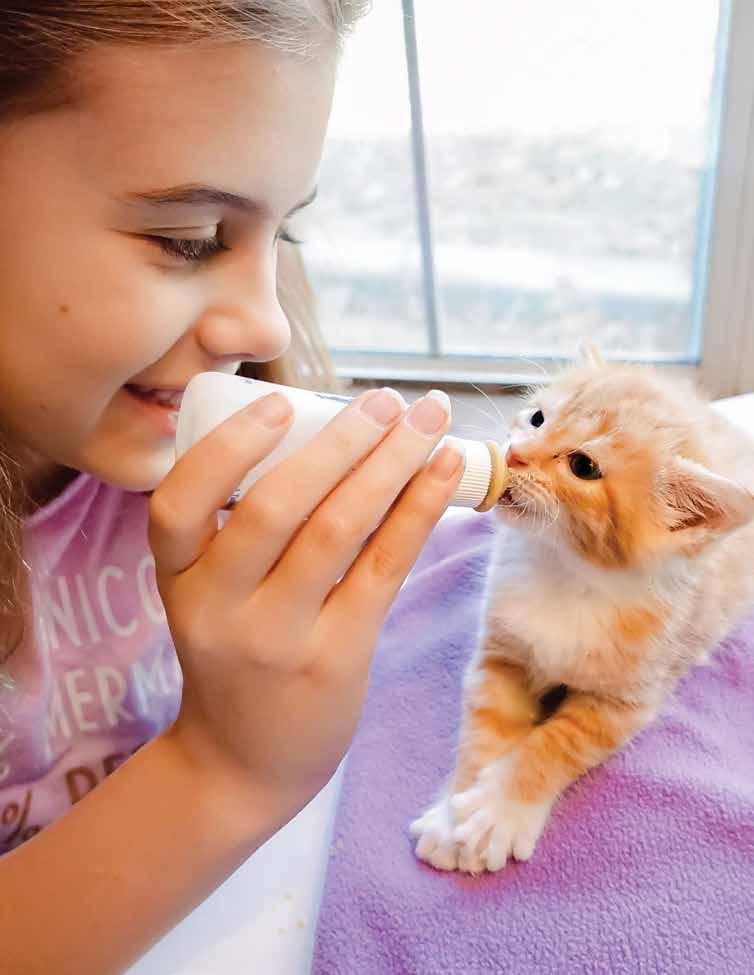
BY TAMARA
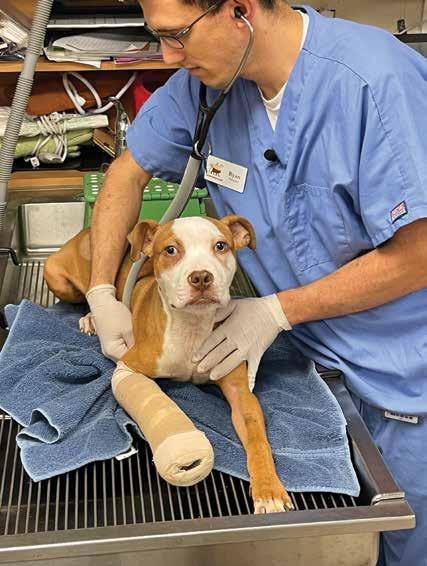
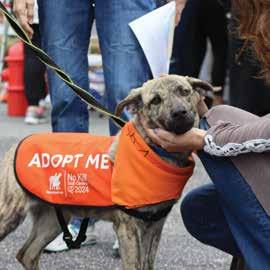
PET ADOPTIONS
Found families for 5,040 homeless animals, from hamsters to horses, mostly dogs and cats.
LOST & FOUND
Reunited 698 lost animals with their loved ones through 4,188 hours of research and casework.
FOSTER HOMES
Cared for 2,616 of the most helpless and vulnerable animals through volunteer foster homes so they can lead healthy and thriving lives with families.
EMERGENCY RESCUE
Rescued 589 animals from harm’s way through 63 emergency rescue operations

SPAYING / NEUTERING
Spayed or neutered a record breaking 15,406 animals to prevent the births of countless unwanted litters.
SHELTER MEDICINE
Alleviated suffering of 9,669 sheltered animals through needed veterinary care in the Sam Greer Spay-Neuter Clinic.
DISEASE PREVENTION
Administered 35,961 lifesaving vaccines to prevent the outbreak of deadly diseases such as rabies.
COMMUNITY CAT PROGRAM
Sterilized, vaccinated, and microchipped 2,656 community cats, followed by the return to their natural habitat to reduce their population and prevent thousands of homeless kittens and free roaming cats, along with preventing the deaths of countless birds
ADVOCACY & INVESTIGATIONS
Provided forensics investigation support to law enforcement agencies in 85 cruelty cases.
COMMUNITY MEDICINE
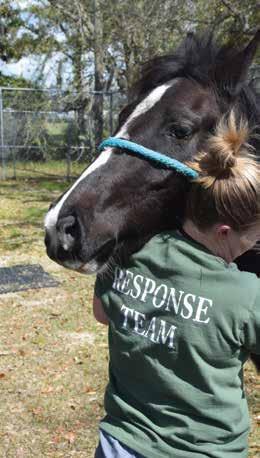
Provided 2,442 dogs and cats with veterinary care, pet food, and emergency veterinary assistance to help keep them safe and healthy with their families.
TEACHING COMPASSION
Taught 34,384 compassion lessons to 11,671 students, helping to reduce violence to people and animals while reinforcing humanitarian values.
FERAL CAT SANCTUARY
Prevented suffering and cruelty for 152 displaced or threatened outdoor cats through permanent sanctuary.
BY ALDWIN ROMAN, CAWA
Charleston Animal Society Vice President and Chief Operating Officer
For many people, when they think of Charleston Animal Society, they think of the thousands of homeless, injured, and unwanted animals taken into the shelter every year. But for the Animal Society, the work goes beyond the walls of the shelter to also help animals in the community that are already in homes. For 150 years, the mission of Charleston Animal Society has stayed the same, the prevention of cruelty to animals.
Charleston Animal Society launched the Pets for Life program in North Charleston. It all started in the Chicora-Cherokee neighborhood, a community that was a resource desert for both people and animals. The Pets for Life program had staff going door-to-door, offering support and resources to families with animals.
Three years into the program, Charleston Animal Society’s Pets for Life program was named the best in the entire country by the Humane Society of the United States.
Over the past 10 years, the Pets for Life program has helped
over 6,000 animals.
Sheltering animals is a response, not prevention. Truly accomplishing our mission means that animals need to never enter a shelter in the first place.
Charleston Animal Society created response and prevention programs to support families and their animals, helping families keep their pets for life. In 2018, the Helping Hands for Rural Paws program was started to bring free veterinary care to rural communities across Charleston County. The program would eventually grow into Dorchester and Berkeley Counties.
The star of this program was the Simon Greer Mobile Spay-Neuter Clinic, a fully equipped mobile veterinary clinic and surgical unit, purchased and donated by Board Members Hank and Laurel Greer.
Four years and 15,000 miles later, the program had helped nearly 4,000 animals that had little to no access to veterinary care. As one participant told the Society, “It’s perfect, because most of the people living in rural areas can’t make it to veterinary clinics.”
Back in 2014, before the Helping Hands program,
Sometimes it was dog training advice or a free collar and leash, but many times it was free spay and neuter along with help transporting animals to their appointments. Time and again, staff met families that loved their animals but just didn’t have the resources to help them. Over the past 10 years, the Pets for Life program has helped over 6,000 animals.
Whether inside or outside the shelter, Charleston Animal Society is all about creating solutions to help animals in need.
2024 SNAPSHOT:
• Charleston Animal Society cared for almost 20,000 animals
• 200,000 animals currently live in Charleston County
• Charleston County Human Population: 429,384
• 1 out 10 people live at or below the poverty line
Charleston Animal Society’s outreach programs have assisted families with pets in rural and urban areas.
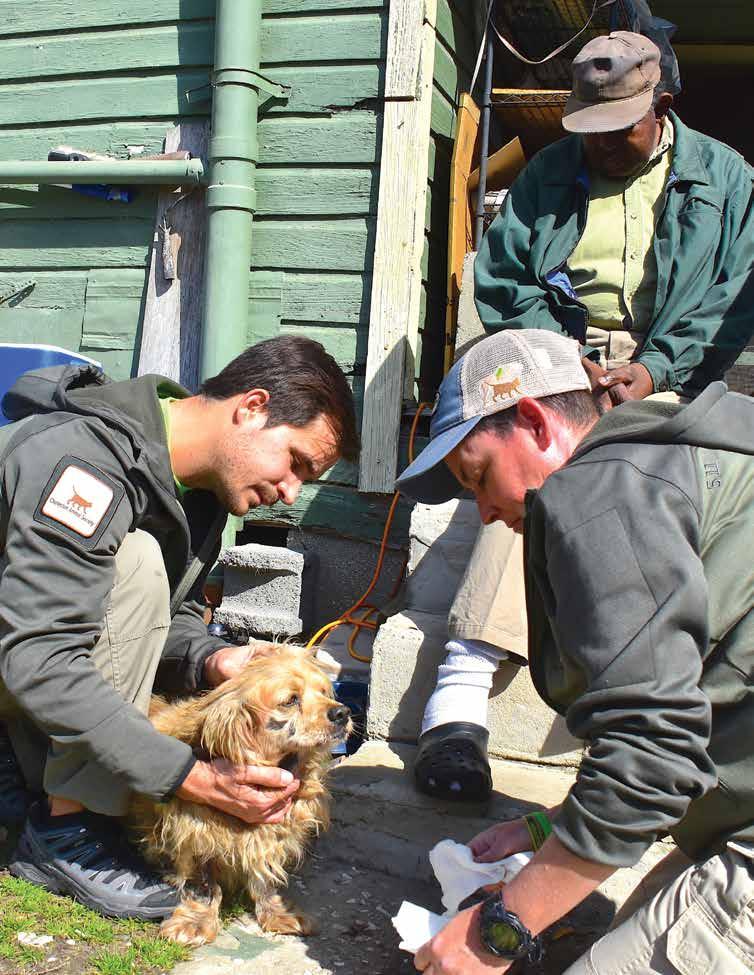
No Kill South Carolina Chief Project Officer Abigail Appleton checks in with a GUINNESS WORLD RECORDS ™ official at VAX-A-PALOOZA ™
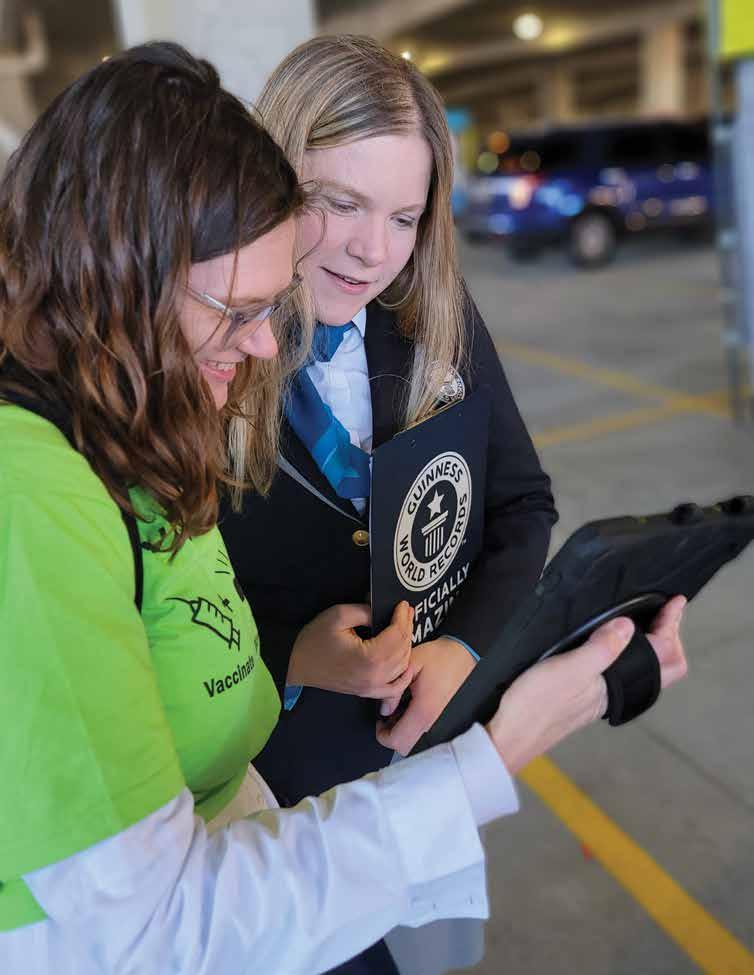
DAN KROSSE Editor-in-Chief
Considered a model of lifesaving success through animal sheltering and prevention strategies, Charleston Animal Society is also in the business of breaking records. In 2023, Charleston Animal Society broke the GUINNESS WORLD RECORDS™ title for most pledges received for a pet vaccination campaign in 24 hours, while also setting numerous South Carolina records for animals.
Organized under the Animal Society’s No Kill South Carolina statewide initiative, over 30 veterinarians, supported by 230 volunteers and staff, participated in VAX-A-PALOOZA™, an animal protection event and campaign designed to enhance public health and safety for both families and the animals that they love.
Hundreds of families brought close to 2,000 animals to the VAX-A-PALOOZA event at the North Charleston Coliseum & Performing Arts Center to receive thousands of lifesaving vaccines such as rabies, distemper, and parvovirus.
In addition to the mega vaccine and microchip clinic event, the other half of VAX-A-PALOOZA was the 24-hour campaign encouraging pet owners to pledge to keep their pets vaccinated against deadly diseases. At the conclusion of VAX-A-PALOOZA, a GUINNESS WORLD RECORDS title was broken with 2,226 pledges as verified by a GUINNESS WORLD RECORDS
Official Adjudicator from the United Kingdom.
“With this World Record, the Lowcountry showed just how much people here truly love their animals,” said Charleston Animal Society President and CEO Joe Elmore, CAWA, CFRE. “We will always remember that it was here in North Charleston, South Carolina, where hundreds of families turned out to vaccinate and microchip their pets while setting a World Record.”
In addition to breaking the GUINNESS WORLD RECORDS title, multiple state records for animals were established, including:
• Most animals vaccinated in a single event
• Most animals microchipped in a single event
• Most animals registered in a digital lost and found system in a single event
• Most veterinarians participating in a single event
As of 2024, Charleston Animal Society set a national record for organizing the largest annual statewide adoption event for dogs and cats for seven years in a row. Pick Me! SC is organized by No Kill South Carolina and brings together shelters and rescues from around the state for a week-long push for over 2,500 adoptions.
Sponsored by Petco Love and Bobs from Skechers, Pick Me! SC has placed more than 12,000 animals into loving homes around the Palmetto State since its inception.
Starting in 2012, Charleston Animal Society earned the distinction as the top-rated nonprofit in the state. Using a variety of metrics including charity watchdog ratings, community awards, and staff certifications, the Society has maintained the honor, while remaining focused on ending unnecessary euthanasia of dogs and cats, overpopulation of dogs and cats, and animal cruelty.
When it comes to certifications, Charleston Animal Society is also on top, having the most employees with their Certified Animal Welfare Administrator (CAWA) credentials. The CAWA program is designed to: independently validate and recognize the knowledge, skills, and achievements of high-level managers working in animal sheltering and field services.
Riding the wave of the blockbuster novel and movie “Gone with the Wind” in the 1940s, Charleston began to cash in on tourists who wanted a taste of the Antebellum South.
As part of this, local businessmen in the 1960s began offering carriage rides. It grew into a multimillion-dollar industry, with several carriage companies now providing tours. While promoted by the city and area tourism agencies, the industry has faced a backlash of criticism from the public.
Polls conducted by local, reputable news organizations showcased the public’s concerns. In a 2015 Post and Courier poll, 70% of those asked said carriage tours should be stopped. Seventy-nine percent of respondents in a News 2 poll in the same year echoed that sentiment. When Charleston Magazine asked if the heat limit for carriage rides should be lowered, an overwhelming 78% surveyed said yes in 2014.
Most people believe that Charleston regulations call for pulling horses off the pavement at 95°. What most people don’t realize is the byzantine process associated with the regulation that requires four consecutive readings, 15 minutes apart, before horses are pulled. If one of those readings falls below 95°, the process starts over. This means horses are rarely pulled. Most other cities require just one heat reading.
When factoring in humidity, horses aren’t pulled until four consecutive readings of 110°! For years, the official thermometer was located on top of a downtown hotel, nowhere near the pavement with its additional ambient heat. Internal temperatures of horses are self-monitored by carriage company employees, not regulators.
In 2006, in response to a whistleblower’s photos of mistreatment, Charleston Animal Society was asked to participate on a committee that helped draft the current city ordinance regarding the humane treatment of horses. But in 2015, the Society made a review of the industry and found that many parts of the city ordinance were not being followed. One example is that horse carriages were to be weighed before each trip (to make sure a horse was not pulling more than three time its body weight) and this was not being done.
Offers from the Society to purchase a scale for the industry to start weighing the wagons was repeatedly rebuffed by Charleston leaders. Charleston Animal Society also advocated for an independent, scientific, peer-reviewed study of the industry to help create guidelines – but this is another suggestion turned down by the city and the industry.
By the 2010s, mobile phones equipped with photo and video cameras would crack the façade of the carriage industry as “genteel.” Time and again, runaway carriages and horses named Big John, Ervin, Blondie, and more were captured by cell phone cameras in various stages of distress.
In 2017 Big John’s case went viral after he collapsed on Meeting Street. The video of the incident videotaped by eyewitnesses has been viewed more than 70,000 times. Members of the carriage industry used the Big John case to unsuccessfully sue Charleston Animal Society in what many viewed as an effort to halt advocacy efforts.
As Charleston Animal Society celebrates a 150-year legacy of care, the organization will continue to work as a watchdog on the industry, until Charleston moves away from having the harshest working conditions in the country.
Big John fell to the ground on Meeting Street while on a tour in 2017, one of several incidents involving carriage industry animals over the years.
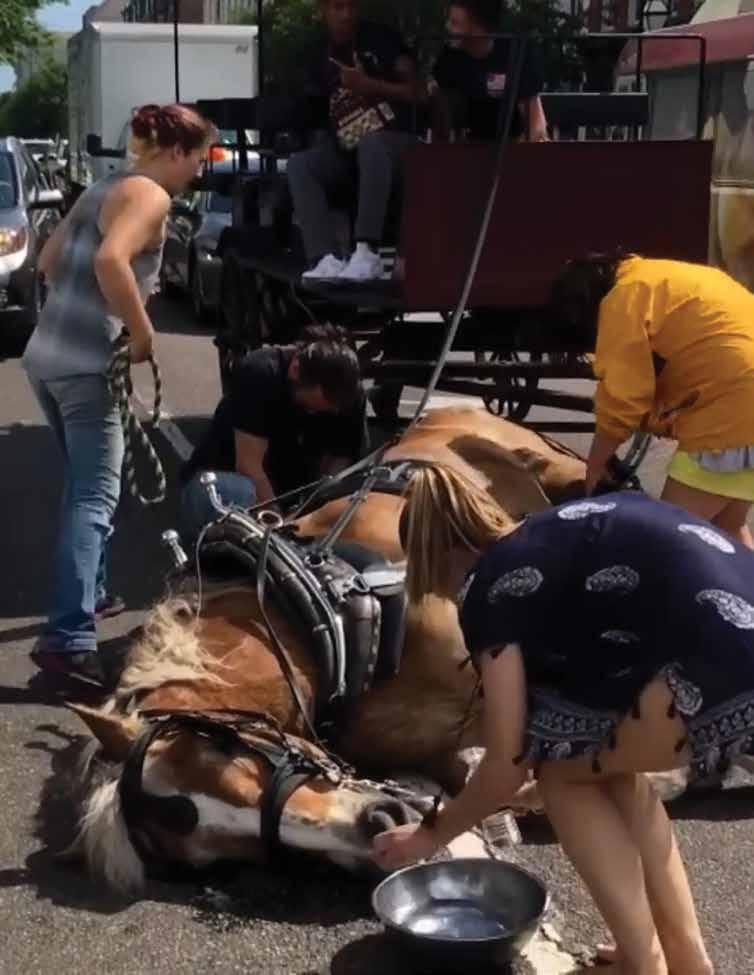
South Carolina Governor Henry McMaster presented Hank and Laurel Greer with the Order of the Palmetto in 2024, the state's highest civilian honor. The Greers both serve on the Board of Charleston Animal Society and volunteered as the Board Chair at different times. They were the first married couple to receive the Order of the Palmetto.

PHOTO BY WILL HOWELL
BY JOY HUBER, CNAP, SHRM-SCP Charleston Animal Society Vice President and Chief Financial Officer
It’s a mantra heard often in the hallways of Charleston Animal Society, “The gift of your home. The gift of your time. The gift of your donations.” It’s these three gifts that are the backbone of Charleston Animal Society’s past, present, and future.
The gift of providing a home extends far beyond its physical structure. In 2024, Charleston Animal Society adopted nearly 5,000 animals. That means thousands of lives transformed — both animals and humans.
how society perceives and values animal welfare. The dedication and passion of thousands of volunteers at Charleston Animal Society not only enriches the lives of animals but also strengthens the foundation upon which Charleston Animal Society continues to grow and evolve.
It’s these three gifts that are the backbone of Charleston Animal Society’s past, present, and future.
When members of our 300+ foster families open their homes to animals from Charleston Animal Society, they offer these creatures a safe haven where they can heal, recover, and thrive. This act of kindness directly alleviates overcrowding, providing more space and resources for other animals in need of shelter and care.
Time is perhaps one of the most precious gifts one can offer. Volunteering at Charleston Animal Society allows individuals to directly engage with the day-to-day operations that keep the organization running smoothly. From walking dogs and socializing cats to assisting with administrative tasks and fundraising events, volunteers provide invaluable support that enhances the quality of care provided to animals.
Moreover, the impact of volunteering extends beyond the immediate tasks performed. It fosters a sense of community and compassion among volunteers, inspiring others to get involved and making a lasting impact on
Financial contributions and other donations serve as the lifeblood of Charleston Animal Society, enabling the organization to sustain its operations and expand its programs and services. Donations fund critical initiatives such as medical care for injured or sick animals, spay and neuter programs to control pet overpopulation, educational outreach to promote responsible pet ownership, and emergency response efforts during natural disasters.
These funds also support ongoing efforts to advocate for stronger animal protection laws and policies, ensuring that the rights and welfare of animals are upheld at local, state, and national levels. By donating, individuals not only provide immediate relief and support but also invest in the long-term sustainability and growth of Charleston Animal Society, securing its ability to continue serving animals and the community for years to come.
Throughout its history, Charleston Animal Society has been fortunate to have supporters who give in so many different ways. In 2024, Hank and Laurel Greer were honored with the state's highest civilian honor, the Order of the Palmetto, because of their philanthropy to numerous charities including Charleston Animal Society. The Greers have given generously of their time, their homes, and their donations. To learn how you can give, please visit our website at CharlestonAnimalSociety.org.
BY ABIGAIL APPLETON, PMP, CAWA Charleston Animal Society
No Kill South Carolina Chief Project Officer
The pinnacle of the 150th Anniversary Year for Charleston Animal Society was the accomplishment of the historic milestone making South Carolina a No Kill State! In 2024, for the first time in South Carolina history, 90% of animals entering shelters in the Palmetto State were saved! No Kill South Carolina (NKSC), an initiative of Charleston Animal Society, worked strategically for nine years to decrease euthanasia in shelters by 68%, making this landmark accomplishment possible. Petco Love provided the resources to make South Carolina the first No Kill state in the southern US from Atlantic to Pacific, and across America’s heartland.
NKSC has been a beacon of hope not just for the countless dogs and cats given the chance for life, but for the people who work and care for them, with a statewide, sustainable, and compassionate approach to lifesaving.
The initiative brought shelters, communities, and volunteers together to save and improve the lives of animals. The journey to No Kill was challenging, but the progress animal organizations made together was nothing short of remarkable.
When we launched NKSC in 2016 we knew hardly anything about the state of animal sheltering in South Carolina, so we spent the whole first year listening and learning. The key turning point came in the summer of 2017 when a group of open-admission shelter leaders met at a Days Inn off I-77. We looked around at each other and realized that we were all facing the same problems, and that reaching No Kill might actually be possible. After nine years of work, we are proud to say that it was, and we did!
Working together, more than 810,000 lives were saved since the project launched in 2016. That’s nearly a million pets who were given the chance for life, and who enriched the lives of the people who love them.
A big motivator to achieving this goal was the generous $1 million challenge offered by Petco Love. The organization pledged $1 million to organizations around the state if No Kill South Carolina was accomplished – so the lifesaving work would continue. This was on top of the annual financial support that kept the initiative running.
While a No Kill South Carolina is now a reality, the challenge is to continue to improve the lifesaving rates for both cats and dogs. The answer to saving cats is easy: keep them out of shelters in the first place. Organizations across the state are spaying and neutering cats that live or spend time outdoors and returning them to their outdoor homes. South Carolina has been No Kill for cats since 2023.
And we know that continuing No Kill for dogs is possible, but more challenging. In the post-pandemic world, we’re wrestling with increasing challenges around adoptions, access to veterinary care, and economic worries — but NKSC remains committed. We’re also seeing an increasing proportion of canines entering shelters with medical or behavioral challenges. This isn’t a bad thing! It means that the animals coming to shelters are ones that truly need our help.
As we look to the next 150 years, communities around South Carolina continue to unite, supporting local shelters, and making a lasting impact on the lives of animals in need. Each of us has a role to play in ensuring the ongoing success of No Kill South Carolina 2024.
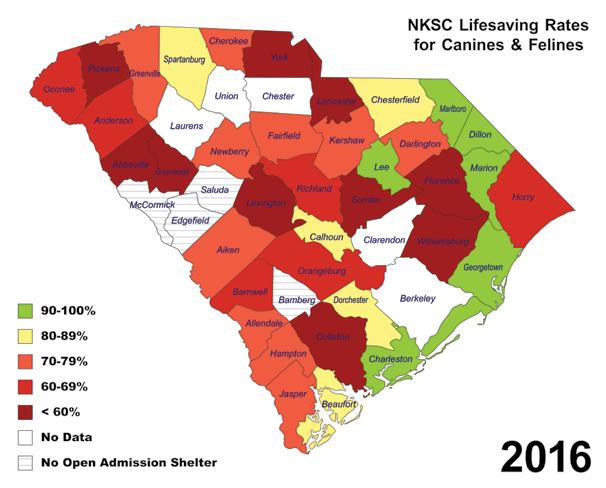
These statewide maps show the progress made by No Kill South Carolina (NKSC) between 2016 and 2024. Counties in dark red were saving less than 60% of animals, while counties in green were saving more than 90% of animals. As the graphic shows, more of the state than ever before is turning green, thanks to NKSC lifesaving initiatives.

Conceptual Architectural rendering of Charleston Animal Society campus expansion project (2024).
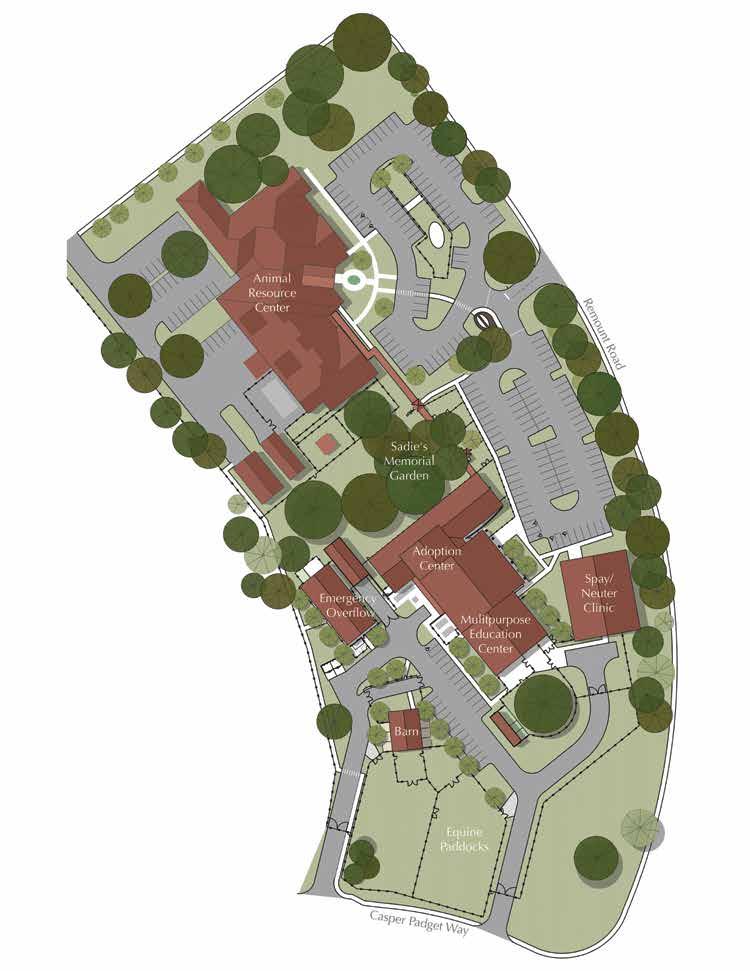
BY HANK AND LAUREL GREER Charleston Animal Society Board Emiriti
As this 150th commemorative issue publishes, Charleston Animal Society is moving forward with plans for a major expansion of its campus at 2455 Remount Road in North Charleston.
In September, the Board of Directors voted to pursue detailed architectural drawings of the multi-building facility that will allow Charleston Animal Society to help animals across the state and lead the organization into the next century.
At the heart of the $40 million expansion is a regional veterinary clinic. With an emphasis on high-volume, high-quality spay-neuter surgeries, vaccinations, microchipping, and basic wellness care, the clinic will become a vital resource for underserved families and overwhelmed shelters across South Carolina. A shortage of veterinary professionals across the state and country has created a bottleneck in spay-neuter services, exacerbating shelter overpopulation. The Society’s expanded clinic will address this by offering services tailored to the needs of local shelters and low-income families. Working with Clemson and other veterinary schools, the clinic will serve as a training ground for veterinary professionals, empowering a new generation of animal welfare workers with skills in shelter health and surgical procedures.
South Carolina’s shelters face recurring challenges of overcrowding and disaster evacuation. The campus expansion will allow for emergency animal sheltering to serve as a centralized hub to address these crises. Whether responding to shelters over capacity, facilitating disaster evacuations, or providing temporary shelter during emergencies, this facility is designed with collaboration
in mind. Charleston Animal Society will work alongside county and state emergency management agencies, the American Red Cross, and other partners to ensure a swift and humane response to disasters.
Charleston Animal Society’s expansion will also introduce a dynamic training center, aimed at fostering compassion, enhancing shelter management, and addressing the shortage of animal care and control professionals. The center will offer hands-on courses in shelter health and animal care, job training for entrylevel workers, and educational programs focusing on high school students.
With a farm animal component to promote humane education and professional development opportunities for shelter staff, the center will bridge critical knowledge gaps in animal welfare. By cultivating compassion in youth and creating career pathways for aspiring veterinary workers, Charleston Animal Society ensures a brighter future for both animals and the community.
Charleston Animal Society’s campus expansion is more than just a series of facilities; it’s a commitment to transforming animal welfare for generations to come. Every aspect ties back to the Society’s founding purpose. By addressing urgent needs in veterinary care, disaster response, cruelty, and education, the Society is setting a bold standard for compassion and innovation. This vision ensures that animals and their caregivers will have the resources and support they need — not just today, but for the next 150 years.
BY ABIGAIL APPLETON, PMP, CAWA
Charleston Animal Society
No Kill South Carolina Chief Project Officer
The state of animal sheltering in South Carolina is at a critical juncture. While progress has been made in recent years to improve the welfare of animals, significant challenges remain, threatening the future of shelter operations and the wellbeing of countless animals.
“It’s a combination of three factors: the poor state of shelter funding, the national veterinary shortage, and the explosive population growth in our state – more development means more people and more animals,” said Charleston Animal Society President and CEO Joe Elmore, CAWA, CFRE. “Shelters are increasingly struggling to keep their heads above water with this.”
The chronic government underfunding of shelters has been an issue since the concept of animal welfare began in the mid 19th century. Almost two centuries later, many shelters still operate on limited budgets, relying heavily on donations and grants to stay afloat. This financial strain restricts their ability to provide adequate care, hire sufficient staff, and maintain facilities. The lack of funding also hampers the implementation of innovative programs that could improve adoption rates or reduce intake numbers, such as spay-neuter programs, community outreach, and education initiatives.
Another challenge as Charleston Animal Society turns the corner into its next 150 years is the national and statewide veterinarian shortage. This crisis has hit South Carolina especially hard. The Palmetto State ranks 46th out of 50 states in the number of veterinarians per thousand people in population. Of the 75 shelters in South Carolina, 49 have no vets on staff to assist with the medical needs of the animals, which means thousands of homeless pets across our state are going without adequate veterinary care.
Another ripple effect of the shortage is a backlog of animals that could be adopted but can’t because they have not been spayed or neutered. Under state law, animals cannot be adopted without being spayed or neutered. With a shortage of vets, it’s getting more and more difficult to get these surgeries accomplished. Animals who would normally be receiving vaccines are also at risk of not receiving this protection from diseases like rabies and parvo that are easily spread and pose a public health risk.
One bright light on the horizon is the state’s first veterinary college scheduled to open at Clemson University in 2026. Twenty-two states don’t have a veterinary school.
One of the most pressing issues is the overwhelming volume of animals entering shelters. South Carolina continues to struggle with pet overpopulation, driven by a lack of widespread spaying and neutering practices. Unplanned litters contribute significantly to the influx of animals, pushing shelters to their capacity limits. This overcrowding often forces shelters to make difficult decisions, including euthanizing animals that could otherwise be rehomed. While many organizations are working tirelessly to promote spay-neuter programs, the progress is uneven, particularly in rural areas where resources are scarce.
Addressing these challenges will require a coordinated effort from policymakers, nonprofits, and people in communities around the state. Increasing funding for shelters, promoting spay-neuter programs, and improving access to veterinary care are critical first steps. Moreover, fostering a culture of adoption and responsible pet ownership through education and outreach can help reduce the strain on shelters over time.
By tackling these issues head-on, we can create a more humane and effective system that ensures every animal has the opportunity for a better life.
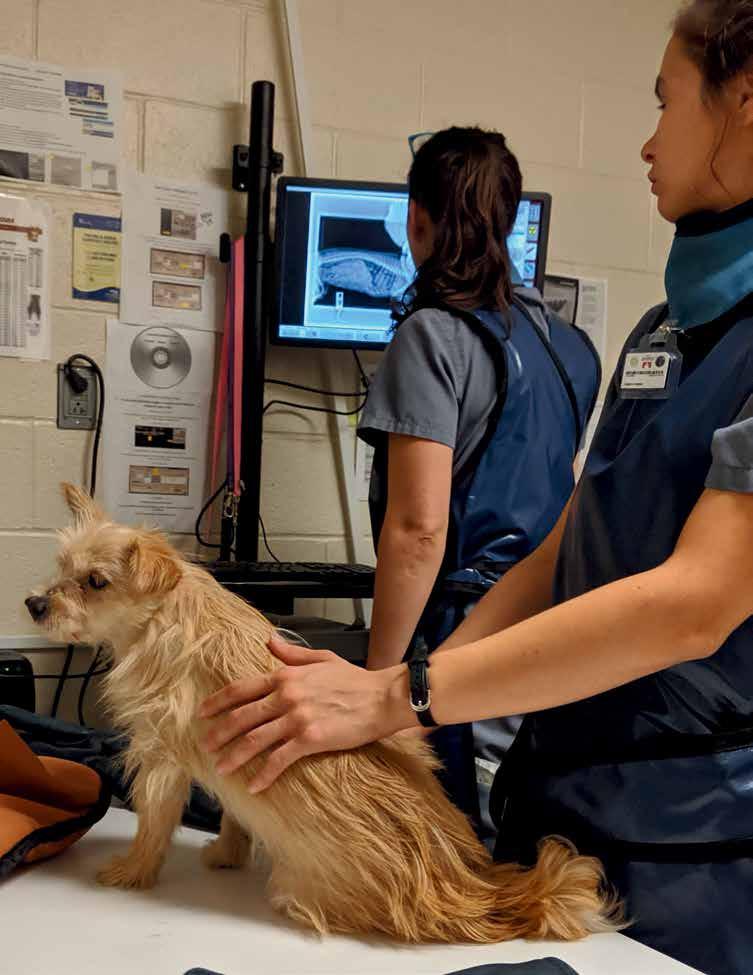
Charleston Animal Society is fortunate to have veterinarians for animals, because out of 75 shelters in South Carolina, 49 do not have any veterinarians on staff.
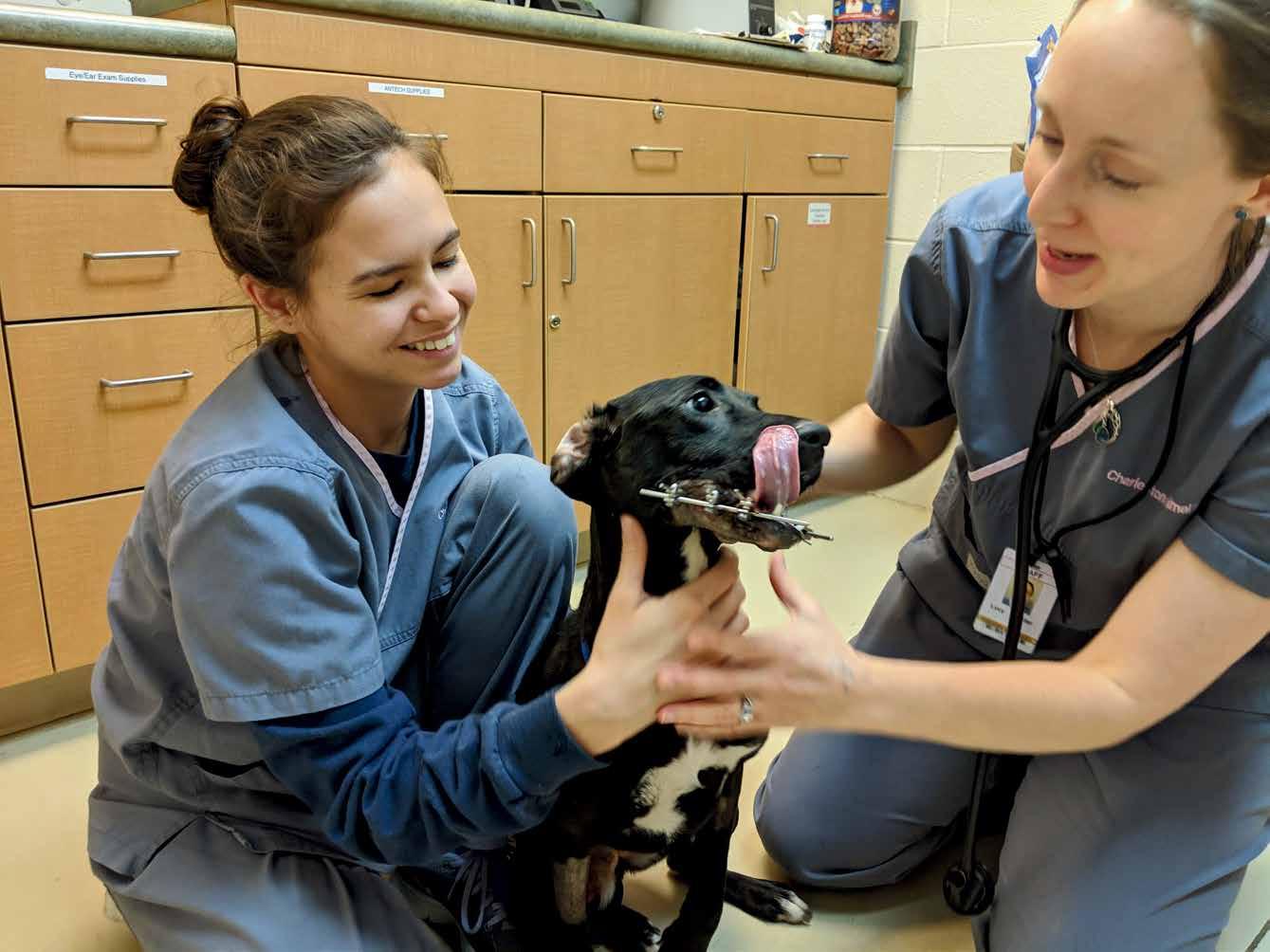
Lucky the dog came to Charleston Animal Society with a shattered jaw after being hit by a car. After receiving lifesaving treatment, Lucky found a new, loving home.
PHOTO BY DAN KROSSE
As we culminate the 150th year of Charleston Animal Society, I am reminded what a monumental milestone this is for the organization, community, region, country, and the animal protection movement. Since a cadre of Charleston’s citizens founded the organization in 1874 as the state’s first animal protection organization and one of the oldest in our nation, the organization has been a solid thread in the Lowcountry’s tapestry.
Undeniably, the Animal Society has been instrumental in shaping the community’s animal ethos over the past century and a half. The Animal Society has influenced the evolution of our community — in both, the Lowcountry and the state. In more recent years, the Animal Society has become influential in the larger animal protection movement, becoming an international model for lifesaving success.
Institutions founded and sustained by local citizens and leaders drive community progress. These institutions are platforms for societal change — and the structure of civilization as we know it. Without faith and charitable pillars of strength, a community cannot form. Because communities don’t just appear — they are built. They take generations of hard work to advance in a direction where families, including animals and pets, can thrive in a safe and healthy environment. Like families, crops, enterprises, and so much more, communities require driving forces to thrive.
The sesquicentennial milestone is not only an unprecedented milestone for animal protection in our state, but it also affirms that animals are important in the lives of South Carolina families. And, with the greatest threat to animals in South Carolina continuing to be the inaction of various governments, both local and statewide, it is critically important for families
to demand forward-thinking and action for local governments to adopt leading practices in the animal care and sheltering fields.
Introducing innovative animal protection strategies, setting state, national, and world records, initiating legislation, conveying the importance of spaying and neutering pets as a lifesaving measure, utilizing animals in teaching compassion to children, building the first No Kill community in the southeastern United States — all are milestones that continue to drive the progress and evolution of Charleston, the Lowcountry, and beyond.
Thank you Charleston, the Lowcountry, and South Carolina for your support and efforts to improve the plight of animals. While we have much more work to do, keeping in mind that South Carolina ranks #47 in U.S. State Animal Protection Laws, we must remain steadfast and not waiver from our resolve in this noble cause.
Onward and upward for another 150 years!
Joe Elmore, CAWA, CFRE Charleston Animal Society President and CEO
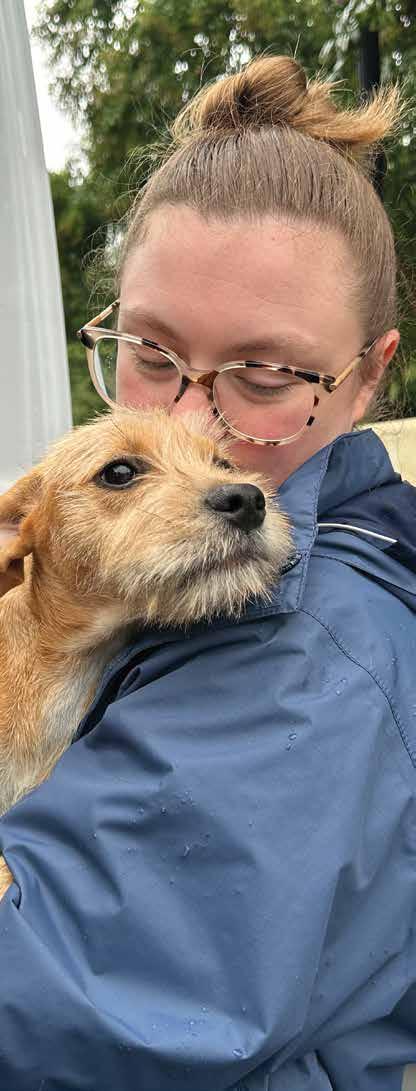
The Charleston Animal Society Board of Directors thanks You for 150 Years of Support for the Animals.
BOARD OFFICERS
Martin Deputy, Board Chair
Gerri Greenwood, Vice Chair
Aussie Geer, Vice Chair
Jane Graham, Vice Chair
Donald Smith, Treasurer
Patricia Henley, Secretary
BOARD MEMBERS
William Asche, Esq.
Linda Bakker
Cara Bibbiani
Luigi Bravo
Caroline Clark
Ted Corvey, Esq.
Tommy Hall
Shelly Leeke, Esq.
MaKeva McDaniel
Brantley Meier, DC
Matt Miller
Arlene Morris
Dick Murphy
Carolyn Murray
Naomie Olindo
Louise Palmer
Pat Waters
BOARD EMERITUS
Hank Greer
Laurel Greer